

How to Teach Argument Writing Step-By-Step

No doubt, teaching argument writing to middle school students can be tricky. Even the word “argumentative” is off-putting, bringing to mind pointless bickering. But once I came up with argument writing lessons that were both fun and effective, I quickly saw the value in it. And so did my students.
You see, we teachers have an ace up our sleeve. It’s a known fact that from ages 11-14, kids love nothing more than to fire up a good ole battle royale with just about anybody within spitting distance.
Yup. So we’re going to use their powers of contradiction to OUR advantage by showing them how to use our argument writing lessons to power up their real-life persuasion skills. Your students will be knocking each other over in the hall to get to the room first!
I usually plan on taking about three weeks on the entire argument writing workshop. However, there are years when I’ve had to cut it down to two, and that works fine too.
Here are the step-by-step lessons I use to teach argument writing. It might be helpful to teachers who are new to teaching the argument, or to teachers who want to get back to the basics. If it seems formulaic, that’s because it is. In my experience, that’s the best way to get middle school students started.
Prior to Starting the Writer’s Workshop
A couple of weeks prior to starting your unit, assign some quick-write journal topics. I pick one current event topic a day, and I ask students to express their opinion about the topic.
Quick-writes get the kids thinking about what is going on in the world and makes choosing a topic easier later on.
Define Argumentative Writing
I’ll never forget the feeling of panic I had in 7th grade when my teacher told us to start writing an expository essay on snowstorms. How could I write an expository essay if I don’t even know what expository MEANS, I whined to my middle school self.
We can’t assume our students know or remember what argumentative writing is, even if we think they should know. So we have to tell them. Also, define claim and issue while you’re at it.
Establish Purpose
I always tell my students that learning to write an effective argument is key to learning critical thinking skills and is an important part of school AND real-life writing.
We start with a fictional scenario every kid in the history of kids can relate to.
ISSUE : a kid wants to stay up late to go to a party vs. AUDIENCE : the strict mom who likes to say no.
The “party” kid writes his mom a letter that starts with a thesis and a claim: I should be permitted to stay out late to attend the part for several reasons.
By going through this totally relatable scenario using a modified argumentative framework, I’m able to demonstrate the difference between persuasion and argument, the importance of data and factual evidence, and the value of a counterclaim and rebuttal.
Students love to debate whether or not strict mom should allow party kid to attend the party. More importantly, it’s a great way to introduce the art of the argument, because kids can see how they can use the skills to their personal advantage.
Persuasive Writing Differs From Argument Writing
At the middle school level, students need to understand persuasive and argument writing in a concrete way. Therefore, I keep it simple by explaining that both types of writing involve a claim. However, in persuasive writing, the supporting details are based on opinions, feelings, and emotions, while in argument writing the supporting details are based on researching factual evidence.
I give kids a few examples to see if they can tell the difference between argumentation and persuasion before we move on.
Argumentative Essay Terminology
In order to write a complete argumentative essay, students need to be familiar with some key terminology . Some teachers name the parts differently, so I try to give them more than one word if necessary:
- thesis statement
- bridge/warrant
- counterclaim/counterargument*
- turn-back/refutation
*If you follow Common Core Standards, the counterargument is not required for 6th-grade argument writing. All of the teachers in my school teach it anyway, and I’m thankful for that when the kids get to 7th grade.
Organizing the Argumentative Essay
I teach students how to write a step-by-step 5 paragraph argumentative essay consisting of the following:
- Introduction : Includes a lead/hook, background information about the topic, and a thesis statement that includes the claim.
- Body Paragraph #1 : Introduces the first reason that the claim is valid. Supports that reason with facts, examples, and/or data.
- Body Paragraph #2 : The second reason the claim is valid. Supporting evidence as above.
- Counterargument (Body Paragraph #3): Introduction of an opposing claim, then includes a turn-back to take the reader back to the original claim.
- Conclusion : Restates the thesis statement, summarizes the main idea, and contains a strong concluding statement that might be a call to action.
Mentor Texts
If we want students to write a certain way, we should provide high-quality mentor texts that are exact models of what we expect them to write.
I know a lot of teachers will use picture books or editorials that present arguments for this, and I can get behind that. But only if specific exemplary essays are also used, and this is why.
If I want to learn Italian cooking, I’m not going to just watch the Romanos enjoy a holiday feast on Everybody Loves Raymond . I need to slow it down and follow every little step my girl Lidia Bastianich makes.
The same goes for teaching argument writing. If we want students to write 5 paragraph essays, that’s what we should show them.
In fact, don’t just display those mentor texts like a museum piece. Dissect the heck out of those essays. Pull them apart like a Thanksgiving turkey. Disassemble the essay sentence by sentence and have the kids label the parts and reassemble them. This is how they will learn how to structure their own writing.
Also, encourage your detectives to evaluate the evidence. Ask students to make note of how the authors use anecdotes, statistics, and facts. Have them evaluate the evidence and whether or not the writer fully analyzes it and connects it to the claim.
This is absolutely the best way for kids to understand the purpose of each part of the essay.
Research Time
Most of my students are not very experienced with performing research when we do this unit, so I ease them into it. (Our “big” research unit comes later in the year with our feature article unit .)
I start them off by showing this short video on how to find reliable sources. We use data collection sheets and our school library’s database for research. There are also some awesome, kid-friendly research sites listed on the Ask a Tech Teacher Blog .
Step-By-Step Drafting
The bedrock of drafting is to start with a solid graphic organizer. I have to differentiate for my writers, and I’ve found they have the most success when I offer three types of graphic organizers.
1- Least Support: This is your standard graphic organizer. It labels each paragraph and has a dedicated section for each part of the paragraph.
2- Moderate Support: This one has labels and sections, but also includes sentence stems for each sentence in the paragraph.
3- Most Support: This one has labels and sections and also includes fill-in-the-blank sentence frames . It’s perfect for my emerging writers, and as I’ve mentioned previously, students do NOT need the frames for long and soon become competent and independent writers.
Writing the Introduction
The introduction has three parts and purposes.
First, it has a hook or lead. While it should be about the topic, it shouldn’t state the writer’s position on the topic. I encourage students to start with a quote by a famous person, an unusual detail, a statistic, or a fact.
Kids will often try to start with a question, but I discourage that unless their question also includes one of the other strategies. Otherwise, I end up with 100 essays that start with, “Do you like sharks?” Lol
Next, it’s time to introduce the issue. This is the background information that readers need in order to understand the controversy.
Last, students should state the claim in the thesis statement. I call it a promise to the reader that the essay will deliver by proving that the claim is valid.
Writing the Supporting Body Paragraphs
Each supporting body paragraph should start with a topic sentence that introduces the idea and states the reason why the claim is valid. The following sentences in the paragraph should support that reason with facts, examples, data, or expert opinions. The bridge is the sentence that connects that piece of evidence to the argument’s claim. The concluding sentence should restate the reason.
Writing the Counterclaim Paragraph
The counterclaim paragraph is a very important aspect of argument writing. It’s where we introduce an opposing argument and then confidently take the reader back to the original argument. I tell students that it’s necessary to “get in the head” of the person who might not agree with their claim, by predicting their objections.
It can be tough for kids to “flip the switch” on their own argument, so I like to practice this a bit. I give them several pairs of transitions that go together to form a counterclaim and rebuttal. I also switch up what I call this part so that they use the terminology interchangeably.
- It might seem that [ counterargument . ]However, [ turn-back .]
- Opponents may argue that [ counterargument .] Nevertheless, [ turn back .]
- A common argument against this position is [ counterargument .] Yet, [ turn-back .]
A great way for kids to practice this is to have them work with partners to write a few counterarguments together. I let them practice by giving them easy role-playing topics.
- Your cousins want to jump into a poison ivy grove for a TikTok challenge. Choose your position on this and write a counterargument and turn-back.
- Your friend wants to get a full-face tattoo of their boyfriend’s name. Choose your position on this and write a counterargument and turn-back.
This kind of practice makes the counterargument much more clear.
The concluding paragraph should remind the reader of what was argued in the essay and why it matters. It might also suggest solutions or further research that could be done on the topic. Or students can write a call to action that asks the reader to perform an action in regard to the information they’ve just learned.
My students write about local issues and then turn the essays into letters to our superintendent, school board, or state senators. It’s an amazing way to empower kids and to show them that their opinion matters. I’ve written about that here and I’ve included the sentence frames for the letters in my argumentative writing unit.
I hope this gives you a good overview of teaching argument writing. Please leave any questions below. Please also share your ideas, because we all need all the help we can give each other!
And one more thing. Don’t be surprised if parents start asking you to tone down the unit because it’s become harder to tell their kids why they can’t stay up late for parties. 🙂
Stay delicious!

Narrative Writing Workshop for Middle School ELA

Fiction & Nonfiction Reading -Teach, Practice, Test BUNDLE – Middle School ELA

RACES Writing Introduction to Paragraph Frames DIGITAL & EDITABLE

Bell Ringers
Teaching argumentative writing in middle school ela: part one.
If you teach middle school, you know that teenagers have a lot of opinions! Luckily, you can use that to your advantage when teaching students how to write an argumentative essay. The key is to help students learn to craft well-written arguments with evidence (not just arguing for the sake of it, which middle schoolers can be prone to).
While learning to craft argumentative essays will help students in school, being able to craft and defend an argument is also an important skill for the real world. Writing an argumentative essay or having a debate requires critical thinking skills and the ability to take a stance and back it up.
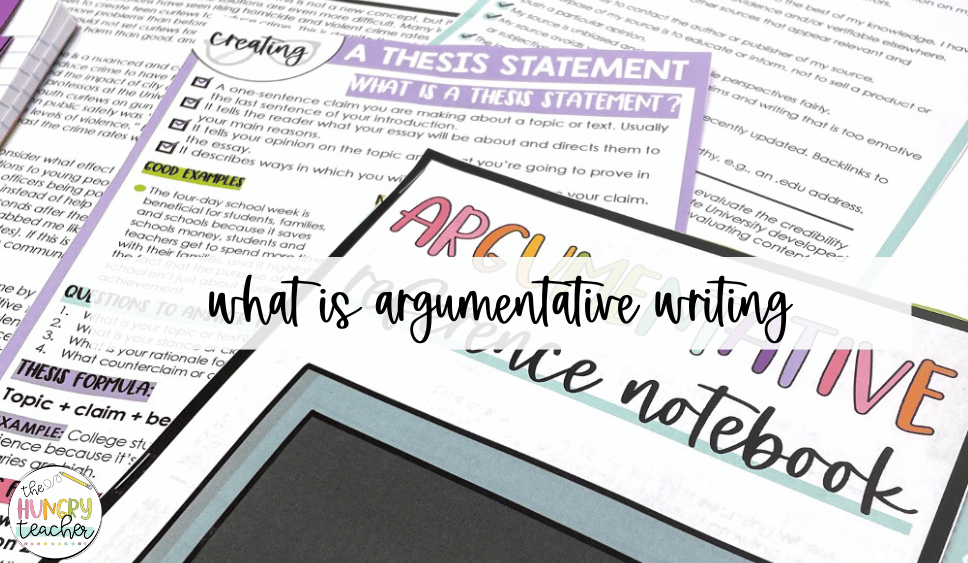
What is Argumentative Writing?
In order for students to understand how to write an argumentative essay, they need to understand what argumentative writing is.
Argumentative essays usually require that students do some investigation or research on a topic and then choose a clear stance. When writing, students will spend the body of the essay explaining points and providing evidence that supports their stance. A counterargument is also typically given as a way to counteract how “nay-sayers” would disagree with the writer. At the end of the essay, students will restate their argument and summarize their evidence.
How to Introduce Argumentative Writing: The Debate
Now that we know what to expect from argumentative writing, we can get into how to write an argumentative essay. You’ll want to start by introducing argumentative writing, which I liked to do through debates. Just like in an essay, to successfully debate a topic, students must do some investigation, choose a stance, and then argue their point in a meaningful way. Holding a class debate is a great place to start when introducing argumentative writing. Debating a topic verbally can actually be used as a brainstorming session before students ever even put pen to paper. For students new to argumentative writing, this takes some of the pressure off of jumping right into the writing process and helps them generate ideas.
There are a few ways you can use debates. For instance, you can choose a topic you’d like students to debate or let them choose a topic they’re already passionate about.
I liked to give students a few minutes to think through the topic and prep on their own, and then I partner them up. They can either debate the topic with their partner, or they can work together with their partner to debate another pair.
Depending on your class size, you could also split the class in half and make it a whole group debate. As long as students are researching or investigating in some way, choosing a stance, and finding reasons to back up their position, there is no wrong way to hold a debate in your class – and you can try out a few different formats to see what works best.
After the debates, it’s a great idea to debrief. This is a good time to bring in some key vocabulary and reinforce how to write an argumentative essay. For example, you can look over some of the evidence presented and ask students to rate the “strength” of the argument. You can also brainstorm a counterargument together.
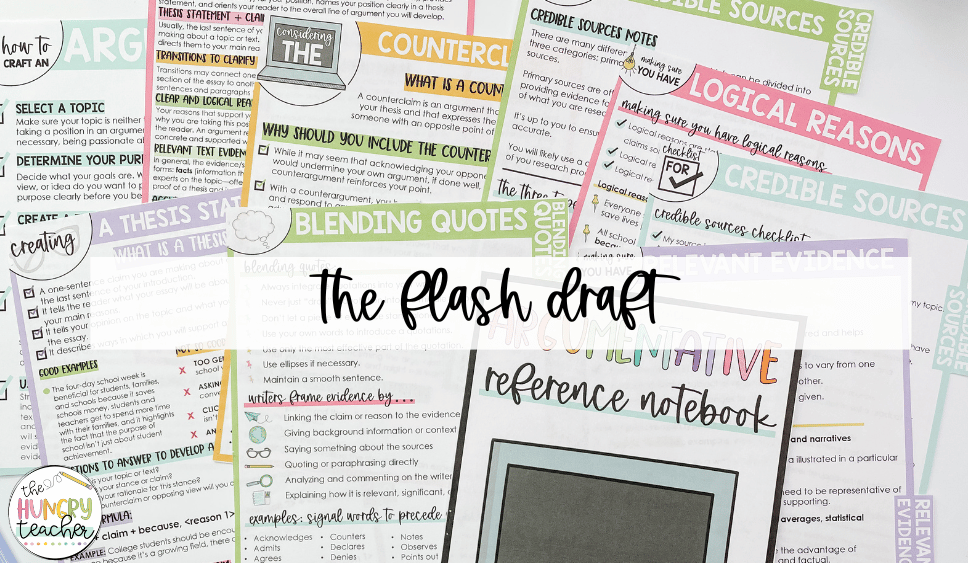
How to Introduce Argumentative Writing: The Flash Draft
After students debate, they move on to the flash draft. A flash draft is essentially a giant brain dump. Students do not have to worry about spelling, grammar, organization, or even structure. They will simply be taking their thoughts from the debate and getting them down on paper.
One benefit to the flash draft is it removes the barrier of intimidation for a lot of students. For many kids, the actual work of starting to write can be daunting. A flash draft removes that intimidation of perfection and just requires something to be on the page. Again, the flash draft portion can be completely tailored to best suit your students and classroom. You can set a timer for a specific amount of time, you can provide students with an outline or guiding questions, or you can give them sentence stems to start.
If you have access to technology in your classroom, you can even let students verbalize their flash draft and use transcription technology to get it on paper.
Expanding Knowledge of Argumentative Writing
By now, you might be wondering when you’ll actually dive deeper into how to write an argumentative essay. That will start with a mini-lesson. These mini-lessons should cover the key parts of argumentative essays, like how to take a stance, ways to support your position, how to transition between thoughts, and even how to craft a counterargument.
You could have a mini-lesson before each flash draft to focus on a particular skill, or you can hold the mini-lesson after the flash draft and let students focus on that skill during revisions. During mini-lessons, I highly suggest using mentor texts, guided examples, or other reference materials. When it comes to writing, many students need to see the process in action, so modeling and having a place for them to reference will be super key to their success.
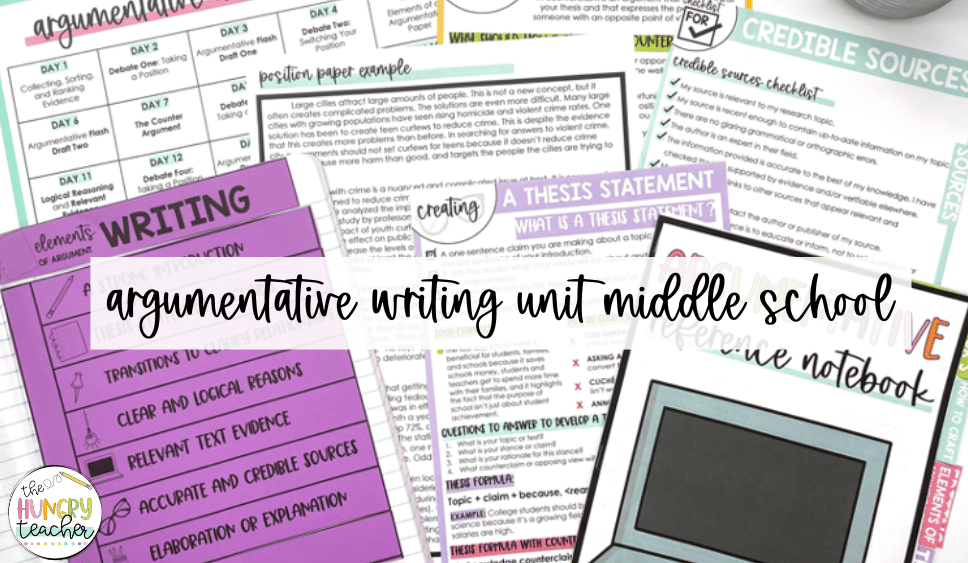
Argumentative Writing Unit for Middle School
Want support putting together your argumentative essay unit? My done-for-you Argumentative Writing Unit scaffolds how to write an argumentative essay for you and your students.
The unit includes 23 full lesson plans, slide presentations, notebook pages for students, teacher keys and examples, student references pages, and more for a well-rounded unit.
Plus, this unit goes through the exact process I talked about in the blog, using debate, flash drafts, and mini-lessons to scaffold students through the writing process.

- Read more about: Middle School Writing
You might also like...
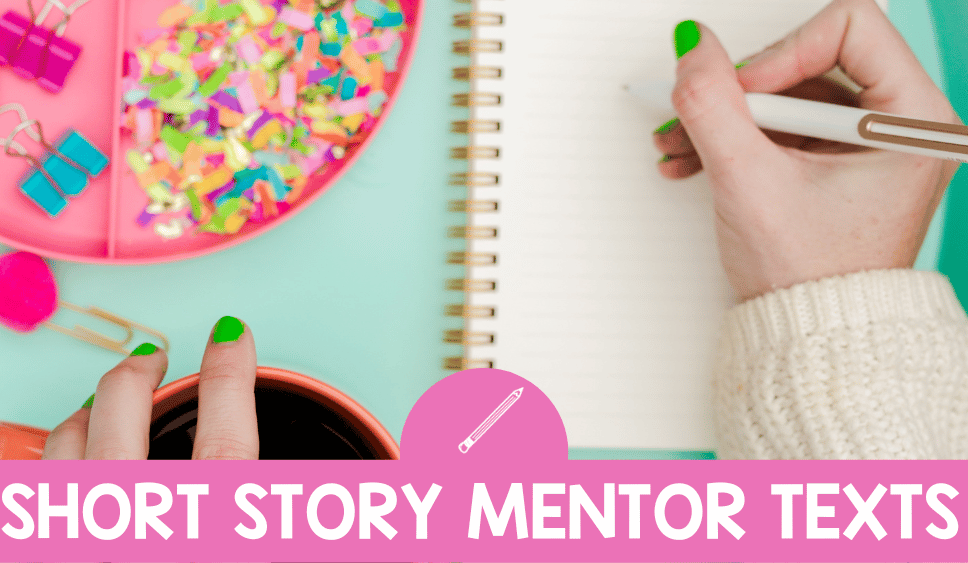
Short Story Mentor Texts to Teach Narrative Writing Elements

Using Mentor Texts for Narrative Writing in Middle School ELA
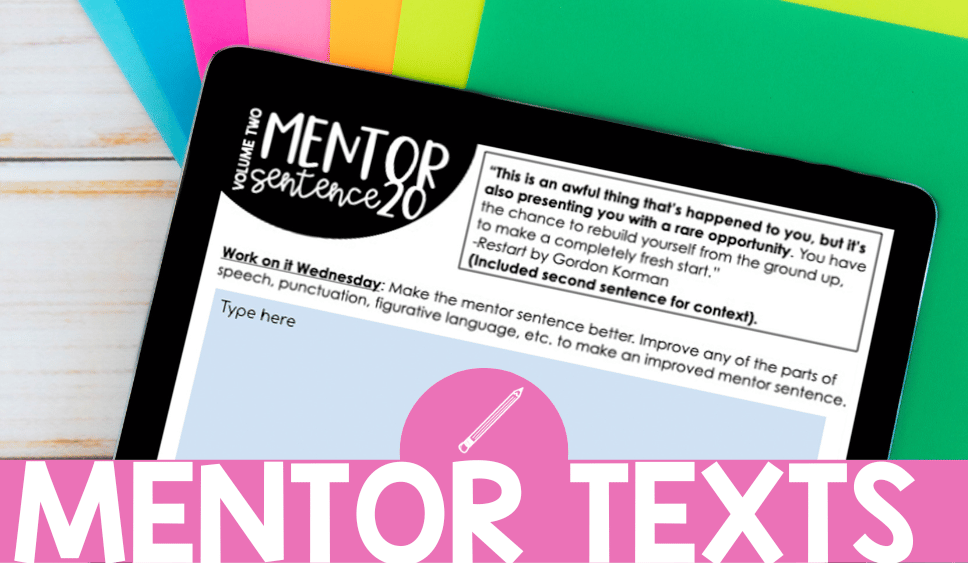
Mentor Texts: When and How To Use Them in Your ELA Lessons
Get your free middle school ela pacing guides with completed scopes and sequences for the school year..

My ELA scope and sequence guides break down every single middle school ELA standard and concept for reading, writing, and language in 6th, 7th, and 8th grade. Use the guides and resources exactly as is or as inspiration for you own!
Meet Martina

I’m a Middle School ELA teacher committed to helping you improve your teaching & implement systems that help you get everything done during the school day!
Let's Connect
Member login.
PRIVACY POLICY
TERMS OF USE
WEBSITE DISCLAIMERS
MEMBERSHIP AGREEEMENT
© The Hungry Teacher • Website by KristenDoyle.co • Contact Martina

45 Argumentative Writing Prompts for Middle School
As students make their way through school, the types of writing they do will change—as will the difficulty.
Writing persuasive or argumentative essays and letters is a great skill for students to learn, and a wonderful way to help guide them on proper research techniques so they can view more than one opinion and form their own conclusions.
Below, we’ve put together a list of writing prompts to help students tackle persuasive writing and dig deeper for an opinion.
Using These Prompts
This writing guide can be used as homework or in tandem with your ELA curriculum. The point is to get students to work on their nonfiction writing skills in a way that is fun and engaging.
Here are a few ways you can use the list below:
- Use these prompts for students who finish work early and need something to do.
- To choose a prompt, have students pick a number between 1 and 45.
- Challenge your students to use one writing prompt every day for a full week.
- Pick prompts that line up with what students are learning in other classes (like history or art).
- Have each student pick a prompt for someone else in the class to use.
The Prompts
- Do you think teachers should assign homework over the weekend? Explain.
- Is America ready to have a woman president? Why or why not?
- Should kids have chores? Explain.
- Should GMOs (Genetically Modified Organisms) be allowed in our food?
- Is life more challenging for your generation than your parents’ generation at your age? Explain.
- Should gym class be required for all students?
- Do you think your school treats boys and girls equally? Explain.
- Do athletes and actors deserve to make more money than the average worker? Explain.
- Do beauty pageants objectify the participants?
- Should teachers accept late work? Explain.
- Should cell phones be allowed in school? Why?
- Do you think community college should be free? Explain.
- Should schools have harsher punishments for bullies?
- Does snail mail (handwritten cards or letters) still have value in the digital age?
- Do you think parents should limit screen time for their children?
- Should a student’s behavior be a factor in their overall grade in a class?
- Explain your stance on alternative energy.
- Do you think the media puts too much pressure on high school and college athletes?
- At what age do you think kids should be allowed to use social media?
- Do you think Native Americans have had justice for having their land stolen?
- Should the US invest more money in the space program, or should that money be spent elsewhere?
- Does society rely too heavily on technology?
- Should single-use plastics be eliminated entirely?
- Do you think students should be given letter grades, or should classes be graded as pass/fail?
- Explain the benefits of learning a second language.
- Does your school mascot represent your school well?
- If your school mascot could be changed, what would you propose? Why?
- Defend your position on recreational hunting.
- Explain the benefits of going away to summer camp.
- Do you think there is anything we can do about climate change, or is it already too late?
- Explain why students should have more say in what they learn.
- What do you think is the perfect pet?
- Is online learning or in-person learning better? Why?
- How has reality TV had an impact on real life?
- At what age are you old enough to stay home alone?
- Should children be required to attend church with their families? Explain your reasoning.
- Do you think the dress code is harmful or helpful to daily school life?
- Is it better to be liked or to be respected?
- Should school start later for teenagers?
- Should students be required to participate in a sport or extracurricular activity?
- Is the glass half-empty or half-full? Explain.
- Should the United States keep daylight savings time, or do away with it?
- What is something every household should do to conserve energy?
- Should beauty standards be more inclusive?
- What is the greatest song of all time? Explain.
Looking For More Resources?
We offer an abundance of free writing resources for parents, guardians, and teachers to help give young writers the tools they need to succeed.
Don’t hesitate to reach out if you are looking for something specific and can’t find it on our site. We love hearing all of your ideas!
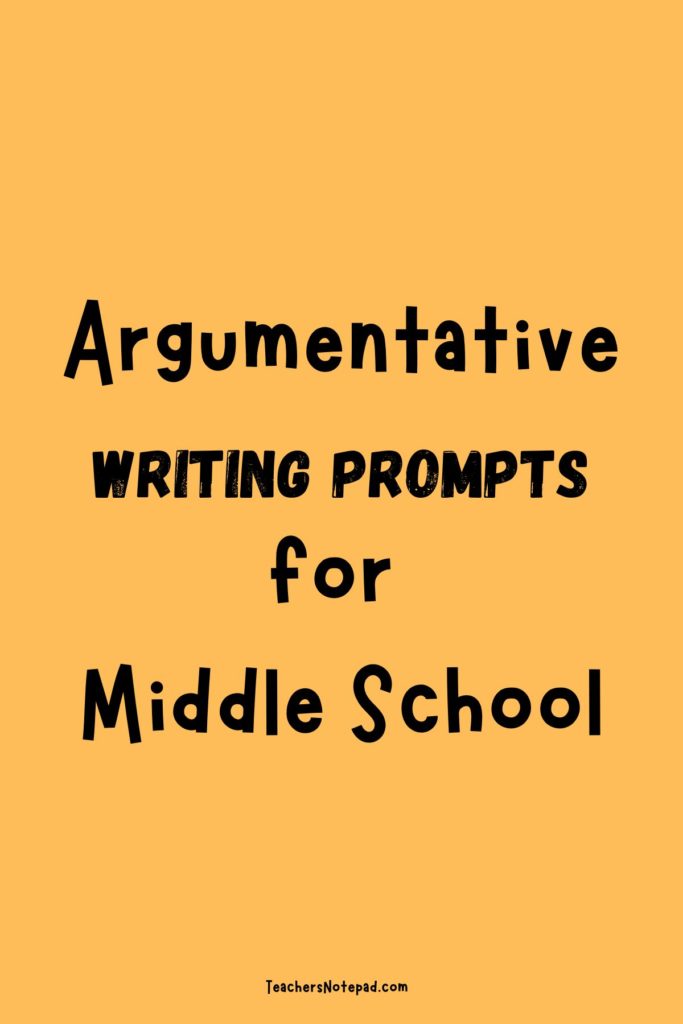
- Share full article
Advertisement
Supported by
Writing curriculum
Argumentative Writing Unit
Writing prompts, lesson plans, webinars, mentor texts and a culminating contest, all to inspire your students to tell us what matters to them.

By The Learning Network
Unit Overview
On our site, we’ve been offering teenagers ways to tell the world what they think for over 20 years. Our student writing prompt forums encourage them to weigh in on current events and issues daily, while our contests have offered an annual outlet since 2014 for formalizing those opinions into evidence-based essays.
In this unit, we’re bringing together all the resources we’ve developed along the way to help students figure out what they want to say, and how to say it effectively.
Here is what this unit offers, but we would love to hear from both teachers and students if there is more we could include. Let us know in the comments, or by writing to [email protected].
Start With Our Prompts for Argumentative Writing
How young is too young to use social media? Should students get mental health days off from school? Is $1 billion too much money for any one person to have?
These are the kinds of questions we ask every day on our site. In 2017 we published a list of 401 Prompts for Argumentative Writing categorized to provoke thinking on aspects of contemporary life from social media to sports, politics, gender issues and school. In 2021, we followed it up with 300 Questions and Images to Inspire Argument Writing , which catalogs all our argument-focused Student Opinion prompts since then, plus our more accessible Picture Prompts.
Teachers tell us their students love looking at these lists, both to inspire their own writing and to find links to reliable sources about the issues that intrigue them. In fact, every year we get many contest submissions that grow directly out of these questions. Several, like this one , have even gone on to win.
But even if you’re not participating in our contest, you might use these prompts to invite the kind of casual, low-stakes writing that can help your students build skills — in developing their voices, making claims and backing them up with solid reasoning and evidence.
And, if your students respond to our most recent prompts by posting comments on our site, they can also practice making arguments for an authentic audience of fellow students from around the world. Each week we choose our favorites to honor in our Current Events Conversation column .
Find Lesson Plans on Every Aspect of Argument Writing
Over the years, we’ve published quite a few lesson plans to support our annual argument writing contests — so many, in fact, that we finally rounded them all up into one easy list.
In “ 10 Ways to Teach Argument-Writing With The New York Times ,” you’ll find resources for:
Exploring the role of a newspaper opinion section
Understanding the difference between fact and opinion
Analyzing the use of rhetorical strategies like ethos, pathos and logos
Working with claims, evidence and counterarguments
Helping students discover the issues that matter to them
Breaking out of the “echo chamber” when researching hot-button issues
Experimenting with visual argument-making
In 2021, we also developed An Argumentative-Writing Unit for Students Doing Remote Learning that can help teenagers guide their own learning.
Teach and Learn With Mentor Texts
You probably already know that you can find arguments to admire — and “writer’s moves” to emulate — all over the Times Opinion section . But have you thought about using the work of our previous Student Editorial Contest winners as mentor texts too?
Here are ways to use both:
Learn from the Op-Ed columnist Nicholas Kristof’s writing process : One edition of our “Annotated by the Author” Mentor Text series is by Mr. Kristof. See what he has to say about the writing challenges he faced in a recent column and how he did the kinds of things students will have to do, too, from fact-checking to fixing grammar errors to balancing storytelling with making a larger point.
Get to know one writer’s rhetorical style : Many teachers use an “adopt a columnist” method, inviting students to focus on the work of one of the Times Opinion columnists to get to know his or her issues and rhetorical style. In 2019, an English teacher in Connecticut wrote for our site about how he does this exercise, in which his students choose from among columnists at The Times, The Washington Post and The Wall Street Journal.
Use the work of teenage winners to help your students identify “writer’s moves” they can borrow: Teachers have told us there is no better way to prepare students to enter our contest than to have them examine the work of previous winners.
On our current site, you can find the essays of the top winners and the runners-up from 2017-202 3. Invite your students to read one and answer the questions we pose in all our Mentor Texts columns : “What do you notice or admire about this piece? What lessons might it have for your writing?” Then, have them borrow one or more of this student’s “writer’s moves” and imitate it in their own work.
We have also published two Learning Network books , one that collects 100 of the best student essays from this contest all in one place, categorized by subjects like “Teenage Life Online,” “Gender and Sexuality” and “Sports and Gaming,” and the other a related teacher’s guide to using them in the classroom.
Here is a roundup of ideas from 17 teachers and students for ways to use these “authentic, powerful and unafraid” student essays in several classroom contexts.
Finally, two new entries in our Annotated by the Author series feature student editorial contest winners from 2020 discussing their work and sharing tips: Ananya Udaygiri on “How Animal Crossing Will Save the World” and Abel John on “Collar the Cat!”
Get Practical Tips From Our Related Videos and Webinars

The video above, “ How to Write an Editorial ,” is only three minutes long, but in it Andy Rosenthal, the former editor of the Times Opinion page, gives students seven great pieces of advice.
Both students and teachers are welcome to watch our popular on-demand 2017 webinar, “ Write to Change the World: Crafting Persuasive Pieces With Help From Nicholas Kristof and the Times Op-Ed Page ,” which includes a wealth of practical tips from Mr. Kristof, as well as from Kabby Hong, a Wisconsin English teacher who works with this contest annually, and his student, Daina Kalnina, whose 2017 essay was one of our top winners that year.
Finally, you can watch our 2021 on-demand webinar, Teaching Argumentative Writing , that focuses on two key steps in the process: finding your argument, and using evidence to support it. You will also get broad overview of how to use our writing prompts and the work of our student winners to help your own students find topics they care about, and craft solid arguments around them. You can also watch an edited version of this webinar below.
Enter Our New Student Open Letter Contest: March 13-April 17, 2024
The culmination of this unit? Our new Open Letter Contest.
An open letter is a published letter of protest or appeal usually addressed to an individual but intended for the general public. Martin Luther King’s Letter From Birmingham Jail , the recent letter signed by over 1,000 tech leaders about the dangers of A.I. and this funny 2020 letter addressed to Harry and Meghan are all examples of this rich tradition.
Just as we did for our long-running Editorial Contest, we invite students to make an argument in 450 words about something that matters to them, and persuade us that we should care, too. But this time, students must address themselves to a specific target audience or recipient, institution or group — one that has the power to make meaningful change.
Whether students choose their parents, teachers, school board members or mayor; a member of Congress; the head of a corporation; or a metonym like “Silicon Valley” or “The Kremlin,” they should ask themselves, What do I care about? Who can make changes, big or small, local or global, to address my issue or problem? What specifically do I want them to understand and do? And how can I write this as an “open letter,” meaningful not just to me and the recipient, but to a general audience?
More information will be published soon. Until then, you can find ideas and inspiration in our related writing unit and via the work of past Editorial winners .
As always, all student work will be read by our staff, volunteers from the Times Opinion section, and/or by educators from around the country. Winners will have their work published on our site and, perhaps, in the print New York Times.

Choose Your Test
Sat / act prep online guides and tips, 3 strong argumentative essay examples, analyzed.
General Education

Need to defend your opinion on an issue? Argumentative essays are one of the most popular types of essays you’ll write in school. They combine persuasive arguments with fact-based research, and, when done well, can be powerful tools for making someone agree with your point of view. If you’re struggling to write an argumentative essay or just want to learn more about them, seeing examples can be a big help.
After giving an overview of this type of essay, we provide three argumentative essay examples. After each essay, we explain in-depth how the essay was structured, what worked, and where the essay could be improved. We end with tips for making your own argumentative essay as strong as possible.
What Is an Argumentative Essay?
An argumentative essay is an essay that uses evidence and facts to support the claim it’s making. Its purpose is to persuade the reader to agree with the argument being made.
A good argumentative essay will use facts and evidence to support the argument, rather than just the author’s thoughts and opinions. For example, say you wanted to write an argumentative essay stating that Charleston, SC is a great destination for families. You couldn’t just say that it’s a great place because you took your family there and enjoyed it. For it to be an argumentative essay, you need to have facts and data to support your argument, such as the number of child-friendly attractions in Charleston, special deals you can get with kids, and surveys of people who visited Charleston as a family and enjoyed it. The first argument is based entirely on feelings, whereas the second is based on evidence that can be proven.
The standard five paragraph format is common, but not required, for argumentative essays. These essays typically follow one of two formats: the Toulmin model or the Rogerian model.
- The Toulmin model is the most common. It begins with an introduction, follows with a thesis/claim, and gives data and evidence to support that claim. This style of essay also includes rebuttals of counterarguments.
- The Rogerian model analyzes two sides of an argument and reaches a conclusion after weighing the strengths and weaknesses of each.
3 Good Argumentative Essay Examples + Analysis
Below are three examples of argumentative essays, written by yours truly in my school days, as well as analysis of what each did well and where it could be improved.
Argumentative Essay Example 1
Proponents of this idea state that it will save local cities and towns money because libraries are expensive to maintain. They also believe it will encourage more people to read because they won’t have to travel to a library to get a book; they can simply click on what they want to read and read it from wherever they are. They could also access more materials because libraries won’t have to buy physical copies of books; they can simply rent out as many digital copies as they need.
However, it would be a serious mistake to replace libraries with tablets. First, digital books and resources are associated with less learning and more problems than print resources. A study done on tablet vs book reading found that people read 20-30% slower on tablets, retain 20% less information, and understand 10% less of what they read compared to people who read the same information in print. Additionally, staring too long at a screen has been shown to cause numerous health problems, including blurred vision, dizziness, dry eyes, headaches, and eye strain, at much higher instances than reading print does. People who use tablets and mobile devices excessively also have a higher incidence of more serious health issues such as fibromyalgia, shoulder and back pain, carpal tunnel syndrome, and muscle strain. I know that whenever I read from my e-reader for too long, my eyes begin to feel tired and my neck hurts. We should not add to these problems by giving people, especially young people, more reasons to look at screens.
Second, it is incredibly narrow-minded to assume that the only service libraries offer is book lending. Libraries have a multitude of benefits, and many are only available if the library has a physical location. Some of these benefits include acting as a quiet study space, giving people a way to converse with their neighbors, holding classes on a variety of topics, providing jobs, answering patron questions, and keeping the community connected. One neighborhood found that, after a local library instituted community events such as play times for toddlers and parents, job fairs for teenagers, and meeting spaces for senior citizens, over a third of residents reported feeling more connected to their community. Similarly, a Pew survey conducted in 2015 found that nearly two-thirds of American adults feel that closing their local library would have a major impact on their community. People see libraries as a way to connect with others and get their questions answered, benefits tablets can’t offer nearly as well or as easily.
While replacing libraries with tablets may seem like a simple solution, it would encourage people to spend even more time looking at digital screens, despite the myriad issues surrounding them. It would also end access to many of the benefits of libraries that people have come to rely on. In many areas, libraries are such an important part of the community network that they could never be replaced by a simple object.
The author begins by giving an overview of the counter-argument, then the thesis appears as the first sentence in the third paragraph. The essay then spends the rest of the paper dismantling the counter argument and showing why readers should believe the other side.
What this essay does well:
- Although it’s a bit unusual to have the thesis appear fairly far into the essay, it works because, once the thesis is stated, the rest of the essay focuses on supporting it since the counter-argument has already been discussed earlier in the paper.
- This essay includes numerous facts and cites studies to support its case. By having specific data to rely on, the author’s argument is stronger and readers will be more inclined to agree with it.
- For every argument the other side makes, the author makes sure to refute it and follow up with why her opinion is the stronger one. In order to make a strong argument, it’s important to dismantle the other side, which this essay does this by making the author's view appear stronger.
- This is a shorter paper, and if it needed to be expanded to meet length requirements, it could include more examples and go more into depth with them, such as by explaining specific cases where people benefited from local libraries.
- Additionally, while the paper uses lots of data, the author also mentions their own experience with using tablets. This should be removed since argumentative essays focus on facts and data to support an argument, not the author’s own opinion or experiences. Replacing that with more data on health issues associated with screen time would strengthen the essay.
- Some of the points made aren't completely accurate , particularly the one about digital books being cheaper. It actually often costs a library more money to rent out numerous digital copies of a book compared to buying a single physical copy. Make sure in your own essay you thoroughly research each of the points and rebuttals you make, otherwise you'll look like you don't know the issue that well.

Argumentative Essay Example 2
There are multiple drugs available to treat malaria, and many of them work well and save lives, but malaria eradication programs that focus too much on them and not enough on prevention haven’t seen long-term success in Sub-Saharan Africa. A major program to combat malaria was WHO’s Global Malaria Eradication Programme. Started in 1955, it had a goal of eliminating malaria in Africa within the next ten years. Based upon previously successful programs in Brazil and the United States, the program focused mainly on vector control. This included widely distributing chloroquine and spraying large amounts of DDT. More than one billion dollars was spent trying to abolish malaria. However, the program suffered from many problems and in 1969, WHO was forced to admit that the program had not succeeded in eradicating malaria. The number of people in Sub-Saharan Africa who contracted malaria as well as the number of malaria deaths had actually increased over 10% during the time the program was active.
One of the major reasons for the failure of the project was that it set uniform strategies and policies. By failing to consider variations between governments, geography, and infrastructure, the program was not nearly as successful as it could have been. Sub-Saharan Africa has neither the money nor the infrastructure to support such an elaborate program, and it couldn’t be run the way it was meant to. Most African countries don't have the resources to send all their people to doctors and get shots, nor can they afford to clear wetlands or other malaria prone areas. The continent’s spending per person for eradicating malaria was just a quarter of what Brazil spent. Sub-Saharan Africa simply can’t rely on a plan that requires more money, infrastructure, and expertise than they have to spare.
Additionally, the widespread use of chloroquine has created drug resistant parasites which are now plaguing Sub-Saharan Africa. Because chloroquine was used widely but inconsistently, mosquitoes developed resistance, and chloroquine is now nearly completely ineffective in Sub-Saharan Africa, with over 95% of mosquitoes resistant to it. As a result, newer, more expensive drugs need to be used to prevent and treat malaria, which further drives up the cost of malaria treatment for a region that can ill afford it.
Instead of developing plans to treat malaria after the infection has incurred, programs should focus on preventing infection from occurring in the first place. Not only is this plan cheaper and more effective, reducing the number of people who contract malaria also reduces loss of work/school days which can further bring down the productivity of the region.
One of the cheapest and most effective ways of preventing malaria is to implement insecticide-treated bed nets (ITNs). These nets provide a protective barrier around the person or people using them. While untreated bed nets are still helpful, those treated with insecticides are much more useful because they stop mosquitoes from biting people through the nets, and they help reduce mosquito populations in a community, thus helping people who don’t even own bed nets. Bed nets are also very effective because most mosquito bites occur while the person is sleeping, so bed nets would be able to drastically reduce the number of transmissions during the night. In fact, transmission of malaria can be reduced by as much as 90% in areas where the use of ITNs is widespread. Because money is so scarce in Sub-Saharan Africa, the low cost is a great benefit and a major reason why the program is so successful. Bed nets cost roughly 2 USD to make, last several years, and can protect two adults. Studies have shown that, for every 100-1000 more nets are being used, one less child dies of malaria. With an estimated 300 million people in Africa not being protected by mosquito nets, there’s the potential to save three million lives by spending just a few dollars per person.
Reducing the number of people who contract malaria would also reduce poverty levels in Africa significantly, thus improving other aspects of society like education levels and the economy. Vector control is more effective than treatment strategies because it means fewer people are getting sick. When fewer people get sick, the working population is stronger as a whole because people are not put out of work from malaria, nor are they caring for sick relatives. Malaria-afflicted families can typically only harvest 40% of the crops that healthy families can harvest. Additionally, a family with members who have malaria spends roughly a quarter of its income treatment, not including the loss of work they also must deal with due to the illness. It’s estimated that malaria costs Africa 12 billion USD in lost income every year. A strong working population creates a stronger economy, which Sub-Saharan Africa is in desperate need of.
This essay begins with an introduction, which ends with the thesis (that malaria eradication plans in Sub-Saharan Africa should focus on prevention rather than treatment). The first part of the essay lays out why the counter argument (treatment rather than prevention) is not as effective, and the second part of the essay focuses on why prevention of malaria is the better path to take.
- The thesis appears early, is stated clearly, and is supported throughout the rest of the essay. This makes the argument clear for readers to understand and follow throughout the essay.
- There’s lots of solid research in this essay, including specific programs that were conducted and how successful they were, as well as specific data mentioned throughout. This evidence helps strengthen the author’s argument.
- The author makes a case for using expanding bed net use over waiting until malaria occurs and beginning treatment, but not much of a plan is given for how the bed nets would be distributed or how to ensure they’re being used properly. By going more into detail of what she believes should be done, the author would be making a stronger argument.
- The introduction of the essay does a good job of laying out the seriousness of the problem, but the conclusion is short and abrupt. Expanding it into its own paragraph would give the author a final way to convince readers of her side of the argument.

Argumentative Essay Example 3
There are many ways payments could work. They could be in the form of a free-market approach, where athletes are able to earn whatever the market is willing to pay them, it could be a set amount of money per athlete, or student athletes could earn income from endorsements, autographs, and control of their likeness, similar to the way top Olympians earn money.
Proponents of the idea believe that, because college athletes are the ones who are training, participating in games, and bringing in audiences, they should receive some sort of compensation for their work. If there were no college athletes, the NCAA wouldn’t exist, college coaches wouldn’t receive there (sometimes very high) salaries, and brands like Nike couldn’t profit from college sports. In fact, the NCAA brings in roughly $1 billion in revenue a year, but college athletes don’t receive any of that money in the form of a paycheck. Additionally, people who believe college athletes should be paid state that paying college athletes will actually encourage them to remain in college longer and not turn pro as quickly, either by giving them a way to begin earning money in college or requiring them to sign a contract stating they’ll stay at the university for a certain number of years while making an agreed-upon salary.
Supporters of this idea point to Zion Williamson, the Duke basketball superstar, who, during his freshman year, sustained a serious knee injury. Many argued that, even if he enjoyed playing for Duke, it wasn’t worth risking another injury and ending his professional career before it even began for a program that wasn’t paying him. Williamson seems to have agreed with them and declared his eligibility for the NCAA draft later that year. If he was being paid, he may have stayed at Duke longer. In fact, roughly a third of student athletes surveyed stated that receiving a salary while in college would make them “strongly consider” remaining collegiate athletes longer before turning pro.
Paying athletes could also stop the recruitment scandals that have plagued the NCAA. In 2018, the NCAA stripped the University of Louisville's men's basketball team of its 2013 national championship title because it was discovered coaches were using sex workers to entice recruits to join the team. There have been dozens of other recruitment scandals where college athletes and recruits have been bribed with anything from having their grades changed, to getting free cars, to being straight out bribed. By paying college athletes and putting their salaries out in the open, the NCAA could end the illegal and underhanded ways some schools and coaches try to entice athletes to join.
People who argue against the idea of paying college athletes believe the practice could be disastrous for college sports. By paying athletes, they argue, they’d turn college sports into a bidding war, where only the richest schools could afford top athletes, and the majority of schools would be shut out from developing a talented team (though some argue this already happens because the best players often go to the most established college sports programs, who typically pay their coaches millions of dollars per year). It could also ruin the tight camaraderie of many college teams if players become jealous that certain teammates are making more money than they are.
They also argue that paying college athletes actually means only a small fraction would make significant money. Out of the 350 Division I athletic departments, fewer than a dozen earn any money. Nearly all the money the NCAA makes comes from men’s football and basketball, so paying college athletes would make a small group of men--who likely will be signed to pro teams and begin making millions immediately out of college--rich at the expense of other players.
Those against paying college athletes also believe that the athletes are receiving enough benefits already. The top athletes already receive scholarships that are worth tens of thousands per year, they receive free food/housing/textbooks, have access to top medical care if they are injured, receive top coaching, get travel perks and free gear, and can use their time in college as a way to capture the attention of professional recruiters. No other college students receive anywhere near as much from their schools.
People on this side also point out that, while the NCAA brings in a massive amount of money each year, it is still a non-profit organization. How? Because over 95% of those profits are redistributed to its members’ institutions in the form of scholarships, grants, conferences, support for Division II and Division III teams, and educational programs. Taking away a significant part of that revenue would hurt smaller programs that rely on that money to keep running.
While both sides have good points, it’s clear that the negatives of paying college athletes far outweigh the positives. College athletes spend a significant amount of time and energy playing for their school, but they are compensated for it by the scholarships and perks they receive. Adding a salary to that would result in a college athletic system where only a small handful of athletes (those likely to become millionaires in the professional leagues) are paid by a handful of schools who enter bidding wars to recruit them, while the majority of student athletics and college athletic programs suffer or even shut down for lack of money. Continuing to offer the current level of benefits to student athletes makes it possible for as many people to benefit from and enjoy college sports as possible.
This argumentative essay follows the Rogerian model. It discusses each side, first laying out multiple reasons people believe student athletes should be paid, then discussing reasons why the athletes shouldn’t be paid. It ends by stating that college athletes shouldn’t be paid by arguing that paying them would destroy college athletics programs and cause them to have many of the issues professional sports leagues have.
- Both sides of the argument are well developed, with multiple reasons why people agree with each side. It allows readers to get a full view of the argument and its nuances.
- Certain statements on both sides are directly rebuffed in order to show where the strengths and weaknesses of each side lie and give a more complete and sophisticated look at the argument.
- Using the Rogerian model can be tricky because oftentimes you don’t explicitly state your argument until the end of the paper. Here, the thesis doesn’t appear until the first sentence of the final paragraph. That doesn’t give readers a lot of time to be convinced that your argument is the right one, compared to a paper where the thesis is stated in the beginning and then supported throughout the paper. This paper could be strengthened if the final paragraph was expanded to more fully explain why the author supports the view, or if the paper had made it clearer that paying athletes was the weaker argument throughout.

3 Tips for Writing a Good Argumentative Essay
Now that you’ve seen examples of what good argumentative essay samples look like, follow these three tips when crafting your own essay.
#1: Make Your Thesis Crystal Clear
The thesis is the key to your argumentative essay; if it isn’t clear or readers can’t find it easily, your entire essay will be weak as a result. Always make sure that your thesis statement is easy to find. The typical spot for it is the final sentence of the introduction paragraph, but if it doesn’t fit in that spot for your essay, try to at least put it as the first or last sentence of a different paragraph so it stands out more.
Also make sure that your thesis makes clear what side of the argument you’re on. After you’ve written it, it’s a great idea to show your thesis to a couple different people--classmates are great for this. Just by reading your thesis they should be able to understand what point you’ll be trying to make with the rest of your essay.
#2: Show Why the Other Side Is Weak
When writing your essay, you may be tempted to ignore the other side of the argument and just focus on your side, but don’t do this. The best argumentative essays really tear apart the other side to show why readers shouldn’t believe it. Before you begin writing your essay, research what the other side believes, and what their strongest points are. Then, in your essay, be sure to mention each of these and use evidence to explain why they’re incorrect/weak arguments. That’ll make your essay much more effective than if you only focused on your side of the argument.
#3: Use Evidence to Support Your Side
Remember, an essay can’t be an argumentative essay if it doesn’t support its argument with evidence. For every point you make, make sure you have facts to back it up. Some examples are previous studies done on the topic, surveys of large groups of people, data points, etc. There should be lots of numbers in your argumentative essay that support your side of the argument. This will make your essay much stronger compared to only relying on your own opinions to support your argument.

Summary: Argumentative Essay Sample
Argumentative essays are persuasive essays that use facts and evidence to support their side of the argument. Most argumentative essays follow either the Toulmin model or the Rogerian model. By reading good argumentative essay examples, you can learn how to develop your essay and provide enough support to make readers agree with your opinion. When writing your essay, remember to always make your thesis clear, show where the other side is weak, and back up your opinion with data and evidence.
What's Next?
Do you need to write an argumentative essay as well? Check out our guide on the best argumentative essay topics for ideas!
You'll probably also need to write research papers for school. We've got you covered with 113 potential topics for research papers.
Your college admissions essay may end up being one of the most important essays you write. Follow our step-by-step guide on writing a personal statement to have an essay that'll impress colleges.

Christine graduated from Michigan State University with degrees in Environmental Biology and Geography and received her Master's from Duke University. In high school she scored in the 99th percentile on the SAT and was named a National Merit Finalist. She has taught English and biology in several countries.
Ask a Question Below
Have any questions about this article or other topics? Ask below and we'll reply!
Improve With Our Famous Guides
- For All Students
The 5 Strategies You Must Be Using to Improve 160+ SAT Points
How to Get a Perfect 1600, by a Perfect Scorer
Series: How to Get 800 on Each SAT Section:
Score 800 on SAT Math
Score 800 on SAT Reading
Score 800 on SAT Writing
Series: How to Get to 600 on Each SAT Section:
Score 600 on SAT Math
Score 600 on SAT Reading
Score 600 on SAT Writing
Free Complete Official SAT Practice Tests
What SAT Target Score Should You Be Aiming For?
15 Strategies to Improve Your SAT Essay
The 5 Strategies You Must Be Using to Improve 4+ ACT Points
How to Get a Perfect 36 ACT, by a Perfect Scorer
Series: How to Get 36 on Each ACT Section:
36 on ACT English
36 on ACT Math
36 on ACT Reading
36 on ACT Science
Series: How to Get to 24 on Each ACT Section:
24 on ACT English
24 on ACT Math
24 on ACT Reading
24 on ACT Science
What ACT target score should you be aiming for?
ACT Vocabulary You Must Know
ACT Writing: 15 Tips to Raise Your Essay Score
How to Get Into Harvard and the Ivy League
How to Get a Perfect 4.0 GPA
How to Write an Amazing College Essay
What Exactly Are Colleges Looking For?
Is the ACT easier than the SAT? A Comprehensive Guide
Should you retake your SAT or ACT?
When should you take the SAT or ACT?
Stay Informed
Get the latest articles and test prep tips!
Looking for Graduate School Test Prep?
Check out our top-rated graduate blogs here:
GRE Online Prep Blog
GMAT Online Prep Blog
TOEFL Online Prep Blog
Holly R. "I am absolutely overjoyed and cannot thank you enough for helping me!”
Developing Evidence-Based Arguments from Texts

About this Strategy Guide
This guide provides teachers with strategies for helping students understand the differences between persuasive writing and evidence-based argumentation. Students become familiar with the basic components of an argument and then develop their understanding by analyzing evidence-based arguments about texts. Students then generate evidence-based arguments of texts using a variety of resources. Links to related resources and additional classroom strategies are also provided.
Research Basis
Strategy in practice, related resources.
Hillocks (2010) contends that argument is “at the heart of critical thinking and academic discourse, the kind of writing students need to know for success in college” (p. 25). He points out that “many teachers begin to teach some version of argument with the writing of a thesis statement, [but] in reality, good argument begins with looking at the data that are likely to become the evidence in an argument and that give rise to a thesis statement or major claim” (p. 26). Students need an understanding of the components of argument and the process through which careful examination of textual evidence becomes the beginnings of a claim about text.
- Begin by helping students understand the differences between persuasive writing and evidence-based argumentation: persuasion and argument share the goal of asserting a claim and trying to convince a reader or audience of its validity, but persuasion relies on a broader range of possible support. While argumentation tends to focus on logic supported by verifiable examples and facts, persuasion can use unverifiable personal anecdotes and a more apparent emotional appeal to make its case. Additionally, in persuasion, the claim usually comes first; then the persuader builds a case to convince a particular audience to think or feel the same way. Evidence-based argument builds the case for its claim out of available evidence. Solid understanding of the material at hand, therefore, is necessary in order to argue effectively. This printable resource provides further examples of the differences between persuasive and argumentative writing.
- One way to help students see this distinction is to offer a topic and two stances on it: one persuasive and one argumentative. Trying to convince your friend to see a particular movie with you is likely persuasion. Sure, you may use some evidence from the movie to back up your claim, but you may also threaten to get upset with him or her if he or she refuses—or you may offer to buy the popcorn if he or she agrees to go. Making the argument for why a movie is better (or worse) than the book it’s based on would be more argumentative, relying on analysis of examples from both works to build a case. Consider using resources from the ReadWriteThink lesson plan Argument, Persuasion, or Propaganda: Analyzing World War II Posters
- The claim (that typically answers the question: “What do I think?”)
- The reasons (that typically answer the question: “Why do I think this?”)
- The evidence (that typically answers the question: “How do I know this is the case?”).
- Deepen students’ understanding of the components of argument by analyzing evidence-based arguments about texts. Project, for example, this essay on Gertrude in Hamlet and ask students to identify the claim, reasons, and evidence. Ask students to clarify what makes this kind of text an argument as opposed to persuasion. What might a persuasive take on the character of Gertrude sound like? (You may also wish to point out the absence of a counterargument in this example. Challenge students to offer one.)
- Point out that even though the claim comes first in the sample essay, the writer of the essay likely did not start there. Rather, he or she arrived at the claim as a result of careful reading of and thinking about the text. Share with students that evidence-based writing about texts always begins with close reading. See Close Reading of Literary Texts strategy guide for additional information.
- Guide students through the process of generating an evidence-based argument of a text by using the Designing an Evidence-based Argument Handout. Decide on an area of focus (such as the development of a particular character) and using a short text, jot down details or phrases related to that focus in the first space on the chart. After reading and some time for discussion of the character, have students look at the evidence and notice any patterns. Record these in the second space. Work with the students to narrow the patterns to a manageable list and re-read the text, this time looking for more instances of the pattern that you may have missed before you were looking for it. Add these references to the list.
- Use the evidence and patterns to formulate a claim in the last box. Point out to students that most texts can support multiple (sometimes even competing) claims, so they are not looking for the “one right thing” to say about the text, but they should strive to say something that has plenty of evidence to support it, but is not immediately self-evident. Claims can also be more or less complex, such as an outright claim (The character is X trait) as opposed to a complex claim (Although the character is X trait, he is also Y trait). For examples of development of a claim (a thesis is a type of claim), see the Developing a Thesis Handout for additional guidance on this point.
- Modeling Academic Writing Through Scholarly Article Presentations
- And I Quote
- Have students use the Evidence-Based Argument Checklist to revise and strengthen their writing.
More Ideas to Try
- This Strategy Guide focuses on making claims about text, with a focus on literary interpretation. The basic tenets of the guide, however, can apply to argumentation in multiple disciplines—e.g., a response to a Document-Based Question in social science, a lab report in science.
- For every argumentative claim that students develop for a text, have them try writing a persuasive claim about the text to continue building an understanding of their difference.
- After students have drafted an evidence-based argument, ask them to choose an alternative claim or a counterclaim to be sure their original claim is argumentative.
- Have students use the Evidence-Based Argument checklist to offer feedback to one another.
- Lesson Plans
- Professional Library
- Student Interactives
- Strategy Guides
Students prepare an already published scholarly article for presentation, with an emphasis on identification of the author's thesis and argument structure.
While drafting a literary analysis essay (or another type of argument) of their own, students work in pairs to investigate advice for writing conclusions and to analyze conclusions of sample essays. They then draft two conclusions for their essay, select one, and reflect on what they have learned through the process.
The Essay Map is an interactive graphic organizer that enables students to organize and outline their ideas for an informational, definitional, or descriptive essay.
- Print this resource
Explore Resources by Grade
- Kindergarten K
Written Business Communication
Short Argumentative Essay Samples for Middle School
Argumentative essays play a significant role in helping students develop critical thinking and persuasive writing skills. Middle school is the perfect time to introduce young learners to practice writing well-structured argumentative essays. In this article, we’ll give you some short argumentative essay samples for middle school students.

The Significance of Argumentative Essays in Middle School
Argumentative essays serve as a powerful tool in the middle school curriculum for several reasons:
- Critical Thinking : Writing argumentative essays encourages students to think critically. They must evaluate evidence, analyze different perspectives, and form their own opinions.
- Persuasive Writing Skills : Developing the ability to persuade others through well-reasoned arguments is a valuable skill that extends beyond the classroom.
- Research Skills : Writing an argumentative essay often requires students to research and cite credible sources, enhancing their research skills.
- Communication Skills : Crafting a coherent argument helps students improve their written and oral communication skills.
See Nine Best Beginner Writing Books You Should Grab here.
Buy 119+ Effective Business Letter Samples here.
You can see the following argumentative essay samples which are really relatable to your homework, project, assignments or personal practice to develop your skills in writing an effective argumentative essays.
Short Argumentative Essay Samples 1
Should students be allowed to have cellphones in school?
Have you ever left one of your books at home when you needed it in the class? You might answer ‘yes’ to the question, but this problem won’t be a big deal if you can just call your family home, right? However, there are some schools that do not allow you to bring your cellphone to school. This situation has created the question of whether students should be allowed to have cell phones in school or not. While some argue that cell phones are disruptive and can hinder learning, I believe that there are strong reasons to support their use in educational settings.
One of the primary reasons students should be allowed to have cell phones in school is for communication purposes. In emergency situations, having a cell phone can be a lifesaver. Parents can reach their children in case of unforeseen circumstances, ensuring their safety. Moreover, students can communicate with their peers and teachers, fostering a collaborative and communicative learning environment.
Cell phones offer access to a vast array of educational resources. With the internet at their fingertips, students can easily look up information, conduct research, and access educational apps. This access can significantly enhance their learning experience, allowing them to delve deeper into subjects and explore a wealth of knowledge beyond traditional classroom materials.
Permitting cell phones in schools can also be a valuable lesson in responsibility. Students must learn to manage their devices appropriately and refrain from using them during class unless instructed otherwise. This promotes self-discipline and helps prepare them for responsible technology use in their future careers.
It’s true that cell phones can be a source of distraction. Critics argue that students may use them to text, play games, or engage in social media during class, diverting their attention from the lesson. However, this challenge can be effectively addressed through policies and guidelines that restrict cell phone use during the class. For example, teachers ask students to collect their cell phones on the designated shelf in the class. At recess, the students can have the phone and use it. When the break time is over, they have to put the phone back; therefore, there will not be any distraction during the next classroom activities.
In conclusion, allowing students to have cell phones in school can be a wise decision if managed effectively. These devices can enhance communication, provide access to educational resources, and teach responsibility. While concerns about distractions are valid, they can be reduced with well-defined guidelines and supervision. Ultimately, embracing technology in the classroom can help students prepare for the digital world they will encounter in the future.
Short Argumentative Essay Samples 2
Is homework necessary for student success, or should it be eliminated?
Homework has long been a subject of debate in our school. Some argue that it is a fundamental component of our success, while others believe it should be eliminated. In my opinion, the merits of homework as a tool for enriching our achievements are irreplaceable.
Homework fosters our responsibility and time management skills. It encourages us to allocate our time wisely, ensuring that we complete our assignments within the given deadlines. These skills are invaluable in the real world, where meeting deadlines and managing one’s time efficiently are crucial. As we know, if we cannot meet the deadline, problems will arise. These problems teach us to avoid delaying something. At the end of the day, the time management skills we learn from doing homework are really crucial in our daily lives.
Homework reinforces what we have learned in the classroom. Repetition is an essential aspect of learning, and homework provides us with the opportunity to practice what we have been taught. This practice leads to better retention of information and an improved understanding of the subject matter. The more we practice, the better we understand the matter. On top of that, some of us might miss something the teacher explains to us. By doing homework, we can get the point that you have missed. Personally, I often feel that I understand more after doing homework.
Homework promotes independent learning. It allows us to dig deeper into a topic, conduct research, and develop problem-solving skills. Independent learning is an invaluable skill that empowers us to take charge of our education and prepares us for lifelong learning.
However, some of us argue that homework can lead to stress and burnout. It is important to acknowledge this concern, but the key is to strike a balance. Teachers should assign reasonable amounts of homework, taking into consideration of our age and extracurricular activities. Additionally, teachers should also design homework that is interesting to do. Therefore, we can enjoy doing the task. Besides, teachers should also wisely provide enough time for us to do the homework. Giving enough can reduce the pressure that the homework might cause. So, we can avoid stress and burnout if teachers properly manage the homework.
To summarize, homework plays a vital role in enhancing student success. It instills responsibility, reinforces learning, and promotes independent study. While concerns about excessive homework are valid, the solution lies in thoughtful assignments and effective time management. Homework is not an enemy but a valuable ally in the pursuit of academic excellence.
Best Books to Improve Communication Skills in English .
Short Argumentative Essay Samples 3
Should school uniforms be mandatory?
In recent years, people debate over whether school uniforms should be mandatory or not. Some argue that uniforms can create a sense of belonging, improve discipline, and reduce socio-economic inequalities. On the other hand, opponents contend that they limit self-expression and can be costly for families. In my opinion, we, students, must wear uniforms for many beneficial reasons.
To begin with, mandating school uniforms can foster a sense of belonging among us. When we wear the same attire, it reduces the visibility of economic disparities, making us feel equal. This, in turn, can contribute to a more inclusive and cohesive school environment. By having uniforms, we feel that we belong to one another. We feel like we are one family.
Uniforms can be a tool for improving discipline, safety, and security. First, when we are dressed uniformly, it becomes easier to identify outsiders, reducing the likelihood of intruders on school grounds. This enhanced security can contribute to a safer learning environment. Secondly, wearing uniforms train us to abide by the rules and regulations. Having uniforms teaches us discipline because we realize that only certain dress is allowed at school. Finally, having a well-designed uniform can also improve our safety. The connection between the dress materials, the size, and the style with types of motion and activities the students do can only be measured by design experts. Not having uniforms will lead us to carelessly choose what kind of dress we wear. At the end of the day, it will reduce our safety. So, I think it is safer to wear school uniforms.
School uniforms can help reduce socio-economic inequalities. Without the pressure to wear expensive, trendy clothing, we can focus on their studies rather than competing in the fashion arena. This levels the playing field, ensuring that we are not judged based on our clothes. As we know, people always want to be the center of attention. School uniforms prevent us from abusing the capability of purchasing attractive clothes, which will demotivate some of us who have less money.
Some people claim that uniforms limit self-expression. While this is an understandable concern, it is important to note that self-expression can still thrive through various means, such as creative accessories or personal grooming choices. Uniforms need not suffocate individuality. Students also have a lot of chances of wearing their favorite clothes outside the school.
To sum up, the mandatory use of school uniforms can create a sense of belonging, improve discipline, and reduce socio-economic inequalities. The benefits of school uniforms in fostering a positive educational environment are vital.
See Descriptive Essay here, or a comparison and contrast essay example here.
To Remember
Creating effective short argumentative essay samples for middle school students is a vital step in their academic development. These essays not only sharpen critical thinking and writing skills but also prepare students for the challenges of the real world. By choosing relevant topics, maintaining a clear structure, and encouraging thoughtful arguments, educators can help middle school students become proficient in the art of persuasion and critical thinking.
Related Posts
Argumentative Essay on Basketball
Argumentative Essay on Music
Argumentative Essay on Animals
Descriptive Essay about Paris
Argumentative Essay on Minimum Wages
Transition Words for Argumentative Essays
Argumentative Essay on Immigration
40 Argumentative Essay Topics for Sixth Graders
Ten Best Books for Construction Business Owners
Best Books to Improve Communication Skills in English
Writing an Argumentative Essay about Fire Prevention
Creating an Engaging Cause and Effect Essay
Argumentative Essay on Social Media
Argumentative Essay on an Ethical Issue
See story elements here.
Argumentative Essay on Death Penalty
Narrative Essay about Overcoming a Challenge
Narrative Essay Example about the Last Moment with My Father
40 Best Narrative Essay Topics
Literacy Narrative Essay Writing | Rubric and Example
Comparison and Contrast Essay Examples
119 Topic Examples for Better Argumentative Essay Writing
Leave a Comment Cancel Reply
You must be logged in to post a comment.
Argumentative Essay Guide
Argumentative Essay Examples
Argumentative Essay Examples: Samples & Tips
11 min read
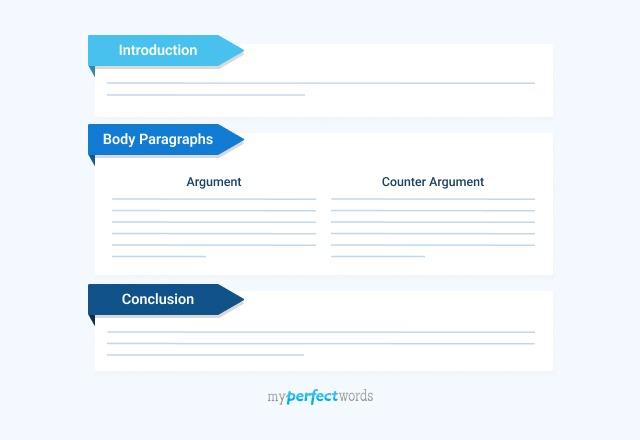
People also read
The Ultimate Guide to Argumentative Essay Writing
250+ Argumentative Essay Topic Ideas To Help You Out
Argumentative Essay Outline: How to Structure Your Argumentative Essay
Learn the 3 Different Types of Argument and Multiple Argument Claims
Have you ever found yourself staring at a blank page, overwhelmed by the thought of composing a powerful argumentative essay ? You're not alone!
Many students encounter the same daunting challenge – how to present a persuasive argument that captivates their audience and drives their point home. Without a clear strategy, it's easy to get lost in a sea of words, leaving your message directionless and your audience unimpressed.
But fear not, for this blog is your roadmap to success!
We're here to provide a number of examples and tips to help you craft compelling arguments, empowering you to tackle your essays with confidence.
By the end, you'll not only understand the key principles of argumentation but also know how to apply them effectively in writing essays.
So read on to find great examples and master the art of writing a good argumentative essay!

- 1. Free Argumentative Essay Examples For Students
- 2. How to Write an Argumentative Essay? Examples
- 3. Interesting Argumentative Essay Topics
- 4. Argumentative Essay Writing Tips
Free Argumentative Essay Examples For Students
A good essay presents facts and data to support an argument, evaluates point of view, and proves its point. It's designed to convince the reader with facts and logic.
Below are some more good argumentative essay examples written by our professional essay writers.

Paper Due? Why Suffer? That's our Job!
6th Grade Argumentative Essay Examples
Looking for inspiration for your 6th-grade argumentative essay? Explore this detailed example crafted specifically for 6th graders.
Argumentative Essay Example for 6th Grade
Argumentative Essay Example Grade 7
With this example, seventh graders can confidently tackle topics they care about.
Argumentative Essay Example for 7th Grade
Grade 8 Argumentative Essay Examples
Right here, we've got 8th grader example of an argumentative essay.
Grade 8 Argumentative Essay Example
Argumentative Essay Examples For Middle School
Middle school essays are pretty basic and easier to debate. Following is an example of middle school argumentative essay:
Argument Essay Example For Middle School
Argumentative Essay Examples For High School PDFs
Here are some amazing argumentative essay examples for high school students. Read them and get an idea of how you can make your argumentative essay flawless.
Argumentative Essay Example for High School
Evaluation Argumentative Essay Example
Counter Argument Essay Example
Argumentative Essay Examples For College Students
When it comes to the college level, essay writing becomes more complicated. At this level, students have to write complex papers like research papers or thesis papers .
Here are some argumentative essay examples pdfs that all college students can use as a guide for their next essay assignment:
Argumentative Essay Example For College
Sample Argumentative Essay For College
Sample Argumentative Essay On Smoking
Argumentative Essay On Gun Control
Argumentative Essay Example for O Level
Following argumentative essay samples can assist you in creating an essay if you are an O Level student.
Social Media Argumentative Essay Example
Short Argumentative Essay Examples
There is no precise word count for an argumentative essay. It just has to persuade the reader and give the author's message to the intended audience.
It can be short or lengthy. It would be considered correct as long as there's a discussion in it.
This is a sample of an argumentative essay.
Short Argumentative Essay Example
Ap lang Argumentative Essay Examples
Argumentative Essay Example About Covid-19
5 Paragraph Argumentative Essay Examples
The traditional argumentative essay outline consists of 5 paragraphs: one introduction, three body paragraphs, and one conclusion.
Here are 5 paragraph argumentative essay examples pdf for crafting an argumentative essay.
5 Paragraph Argumentative Essay
How to Write an Argumentative Essay? Examples
Writing a compelling argumentative essay can be a daunting task, but with the right guidance and examples, it becomes more manageable.
In this section, we'll explore the essential steps along with examples to master the art of crafting persuasive arguments.
Argumentative Essay Examples Introduction
The introduction should include an attention-grabbing hook and background information on the topic. Additionally, it should have a clear thesis statement at the end that outlines the main points of your argument.
After reading through this introduction, readers should have a good understanding of what they can expect from your paper.
Here is a thesis statement for argumentative essay example:
Argumentative Essay Examples with Thesis Statement
Need more examples? Don’t worry! Read out these free argumentative essay examples pdf:
Argumentative Essay Examples Introduction
How to start an Argumentative Essay Examples
How to Write a Body Paragraph of Argumentative Essay
Argumentative essay conclusion example .
The conclusion of your argumentative essay is an important part where everything ties together. It should summarise your main points and reiterate your argument.
Here is an example of what it looks like:
How to End an Argumentative Essay Examples
Tough Essay Due? Hire Tough Writers!
Interesting Argumentative Essay Topics
Choosing an essay topic is sometimes the most difficult part of the writing process. Here are some topics that will help you in brainstorming your topics:
- Should the government impose a curfew on teens?
- Should alcohol advertisements be banned?
- Are cell phones dangerous to our health?
- Is global warming real or fake?
- Should school uniforms be mandatory?
- Does the media influence gender roles in society?
- Is nuclear energy safe?
- Should the death penalty be abolished?
- Should abortion be legal in the United States?
- Is animal testing necessary?
If you are looking for a comprehensive list of topics, check out our argumentative essay topics blog!
Argumentative Essay Writing Tips
When it comes to writing high-quality argumentative essays, there are some solid tips you need to know.
Below are 10 useful tips you should keep in mind while crafting an argumentative essay.
- Choose Engaging Topics
Choosing an engaging topic will make you feel enthusiastic from the moment you start drafting down words in your essay. An argumentative essay topic should always be debatable, arguable, and researchable.
- Choose the Structure
An argumentative essay can be structured in three ways: Classical, Toulmin, and Rogerian. Choose any of these types of arguments to give your essay a logical flow and purpose.
- Conduct Quality Research
Extensive fact-based research goes a long way in producing a good argumentative essay. The more you study, the broader your horizons will be, and you will have just that much more supporting evidence.
- Credible Sources
You can’t expect someone to agree with opposing views without strong and authentic evidence. If you want someone to change their perspective, you need to persuade them with facts from credible sources .
- Use Counter Arguments
One of the most important parts of an argumentative essay is using counter-arguments. Introduce the opposing view in a few short sentences and proceed to refute them with fact-based empirical evidence. This is a powerful way of persuading a reader to agree with your side of the argument.
- Create a Solid Introduction
Remember to pay keen attention to the introduction of your essay, as it can make or break your essay. A strong thesis statement lets your readers know your stance and gives them an idea of your philosophy around the topic.
- Complex Sentences Never Impress
Fancy vocabulary and extremely long sentences are too complex to understand. Your goal is to strike the reader’s mind with intelligent arguments and not try to sound smarter than them. Use simple vocabulary, but be fueled with creativity.
- Clarity and Authority
When writing an argumentative essay, do not come across as reluctant or uncertain. Whatever you do, don’t play both sides or show your strengths and weaknesses simultaneously. You should choose a side and be confident about the points you make.
- Stick to the Essay Length
When writing an argumentative essay, it is very easy to deviate from the assigned essay length given by your instructor. Writing a 4000-word essay while the maximum essay length given by your instructor was 1500 probably isn’t a good idea.
- Avoid Sensitive Topics
Students should avoid hot-button topics like race, sports, politics, and religion at all costs. The last thing you want to do is offend a reader who holds a strong personal opinion of you.
Here is a video with some tips on starting your essay. Be sure to check it out:
In summary, we've explored a wide range of example for different academic levels. These examples will help you in creating strong arguments and using persuasive writing effectively.
Remember, a good argumentative essay isn't just about stating your opinion. It's about stating it clearly, supporting it with solid evidence, and presenting it convincingly.
Moreover, if you need help with writing argumentative essays, our expert writers are here for you. You can trust our legit essay writing service to help you craft engaging argumentative essays.
With us, you will get 24/7 customer support, timely delivery, free revisions, and more benefits! So place your order at our argumentative essay writing service today!

Write Essay Within 60 Seconds!

Nova Allison is a Digital Content Strategist with over eight years of experience. Nova has also worked as a technical and scientific writer. She is majorly involved in developing and reviewing online content plans that engage and resonate with audiences. Nova has a passion for writing that engages and informs her readers.

Paper Due? Why Suffer? That’s our Job!
Keep reading


- About Michelle Waters
- Curriculum Vitae
- Tools I Use
- Podcast Episodes
- How To Be Our Podcast Guest
- Member Login
- Member Helpdesk
- Support Portal
- Resource Partners
- Writing Partners
- Certificate Verification
- How To Contribute
by Michelle Boyd Waters, M.Ed.
A Plethora Of Writing Examples For Middle School (& High School)
October 14, 2014 in Pedagogy

When I started my first job as a professional newspaper reporter (This job also served as an internship during my junior year in college — I just didn’t leave for about 6 years.), I quickly realized that all my experience, and all my years of journalism education had not been enough to help me write stories about drug busts, fatal car accidents and tornadoes. All the theoretical work I’d done, and all of the nifty little scholastic and collegiate stories I had done, did not prepare me for real world writing.
At that point, I had to find a solution quickly. After all, I had a deadline to meet, and it was only a few hours away.
One of my colleagues, who also served as a mentor, had the solution. She introduced me to the newspaper’s “morgue.” This was a room filled with filing cabinets in which we kept old — dead — stories arranged by reporter. Whenever I wasn’t’ sure how to write a story, all I had to do was check the morgue for similar stories. If I needed to write a story about a local drug bust, for example, I’d find another story on a similar incident, study its structure, and mentally create a formula in which to plugin the information I’d gathered.
Once I’d gained more experience, and had internalized the formula for that particular type of story, I felt free to branch out as the situation — and my training — warranted.
I do the same thing when I want to write a type of letter, brochure, or report that I’ve never written before.
This is what writing looks like in the real world.
Of course, if you’re a new teacher like me, there is one problem with providing mentor texts to my students: I have a dearth of middle school level writing sitting around in my file cabinets.
Fortunately, the Internet is full of sources, so I scoured the bowels of Google to find examples. I know how busy you are, so I’m sharing.
Expository writing examples for middle school
Below are several sources of expository writing samples for middle school students.
- The Write Source Expository Writing Samples
- Holt, Rinehart, Winston Expository Essay Models
Finally, here is an article in the New York Times that will help you teach your students real-world expository writing skills .
Descriptive writing examples for middle school
- Descriptive Writing Samples from Novels
- Milwaukee Public Schools Descriptive Essay Samples (p. 137)
- Holt, Rinehart, Winston Descriptive Essay Models
Narrative writing examples for middle school
- Writing Samples by Steve Peha (PDF)
- The Write Source Narrative Writing Samples
- Oregon Department of Education Scored Writing Samples (Ideas and Organization)
- Oregon Department of Education Scored Writing Samples (Sentence Fluency and Conventions)
- Oregon Department of Education Scored Writing Samples (Voice and Word Choice)
- Oregon Department of Education High School Scored Narrative and Argumentative Writing Samples
- Holt, Rinehart, Winston Narrative Essay Models
Argumentative/persuasive writing examples for middle school
- The Write Source Persuasive Writing Samples
- Holt, Rinehart, Winston Persuasive Essay Models
Reflective writing examples for middle school
- Reflective essay examples from Lake Washington Girls Middle School
If you know of any other online writing example sources, please feel free to share them in the comments below.
Related topics: Argumentative Writing , Informative Writing , Mentor Texts , Narrative Writing
About the author
Michelle Boyd Waters, M.Ed.
I am a secondary English Language Arts teacher, a University of Oklahoma student working on my doctorate in Instructional Leadership and Academic Curriculum with an concentration in English Education and co-Editor of the Oklahoma English Journal. I am constantly seeking ways to amplify students' voices and choices.
This is very, very helpful. Thank you for sharing!
As a new middle school teacher (coming from elementary) this was very helpful and encouraging.
Thank you very much for letting me know. I’m glad that I was able to help you!
Thank you! I’m glad I can help.
Your welcome
This is super helpful. Thank you!
These links are a fantastic help. Thank you!
This helped me BUNCHES! Thanks so much!
thanks so much!!!!!!!!!!!!!!!!!!!!!!!!!!!!!!!!!!!!!!!!!!!!!!!!!!!!!!!!!!!!!!!!!!!!!! XD
These links are now dead 🙁
Thank you for notifying me! I have updated the post to include new (live!) links. Some of them are geared towards high school, but I think we can still use them as exemplars of what we want our students to aim for.
Comments are closed.
- Grades 6-12
- School Leaders
Free end-of-year letter templates to your students 📝!
101 Interesting Persuasive Essay Topics for Kids and Teens
Use your words to sway the reader.
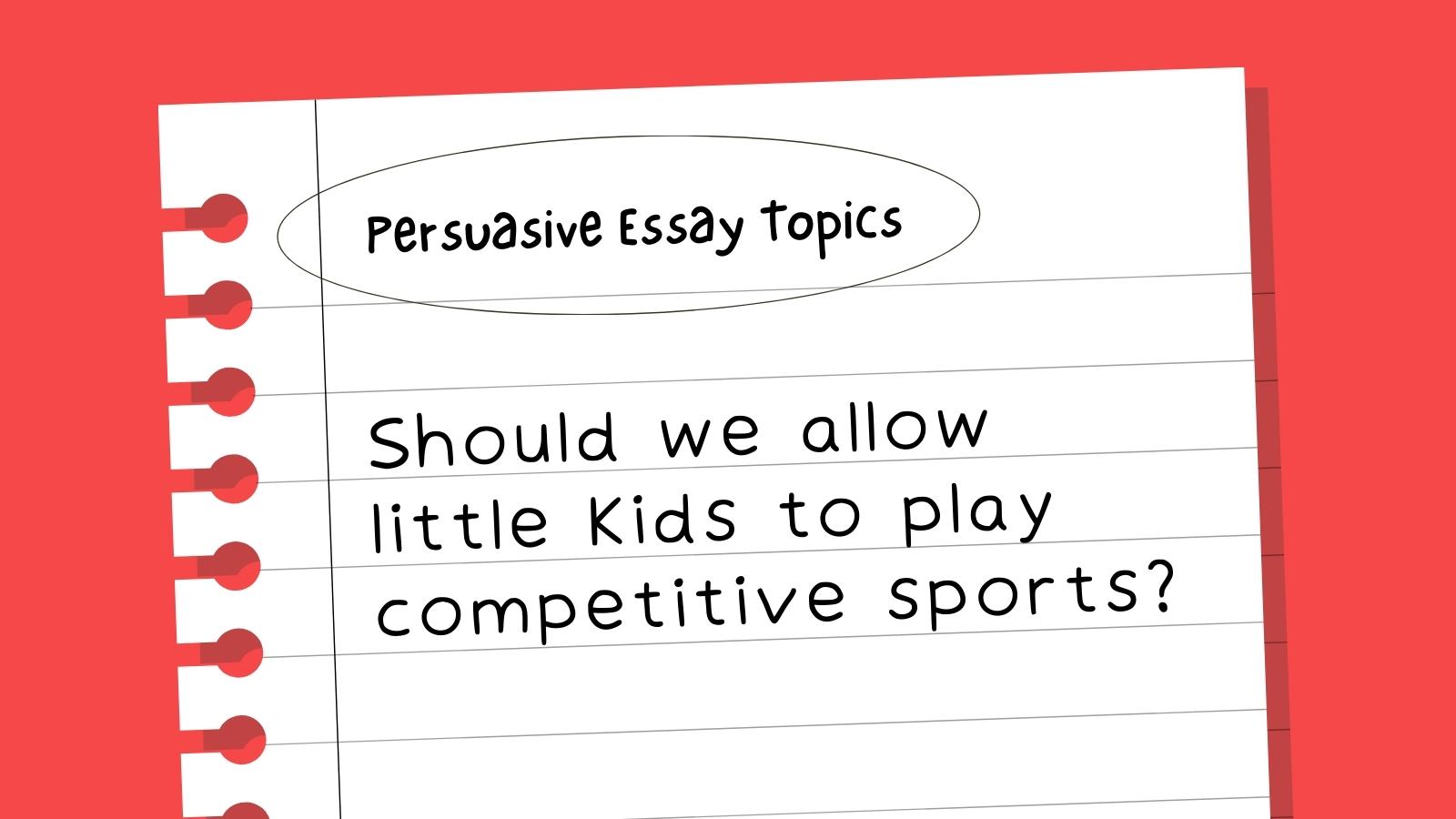
Persuasive writing is one of those skills that can help students succeed in real life. Persuasive essays are similar to argumentative , but they rely less on facts and more on emotion to sway the reader. It’s important to know your audience so you can anticipate any counterarguments they might make and try to overcome them. Try reading some mentor texts to show kids great examples of opinion writing. Then use these persuasive essay topics for practice.
School and Education Persuasive Essay Topics
Life and ethics persuasive essay topics, science and technology persuasive essay topics, sports and entertainment persuasive essay topics, just for fun persuasive essay topics.
- Do you think homework should be required, optional, or not given at all?

- Students should/should not be able to use their phones during the school day.
- Should schools have dress codes?
- If I could change one school rule, it would be …
- Is year-round school a good idea?
- Should we stop giving final exams?
- Is it better to be good at academics or good at sports?
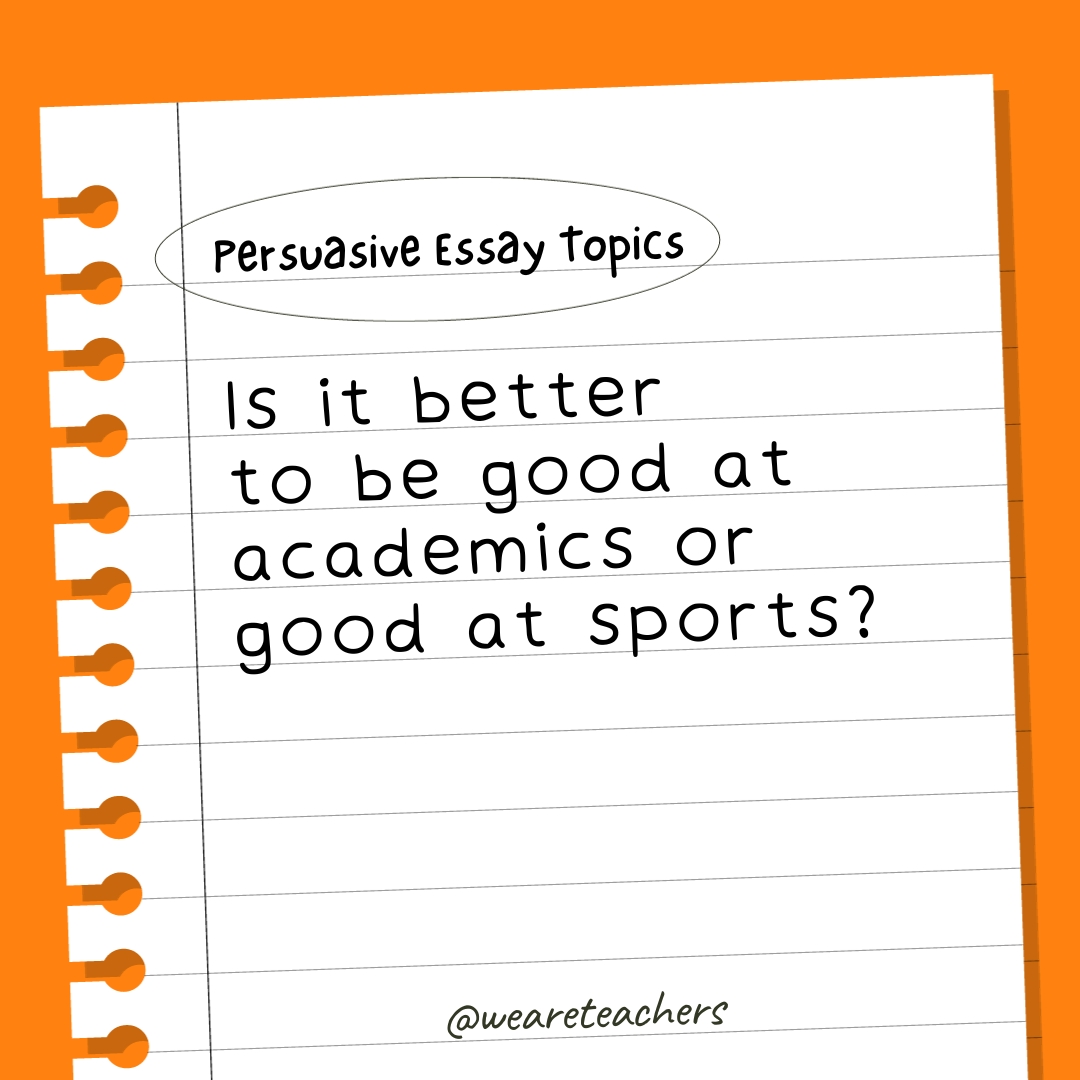
- Which is better, private schools or public schools?
- Should every student have to participate in athletics?
- Do you think schools should ban junk food from their cafeterias?
- Should students be required to volunteer in their communities?
- What is the most important school subject?
- Are letter grades helpful, or should we replace them with something else?
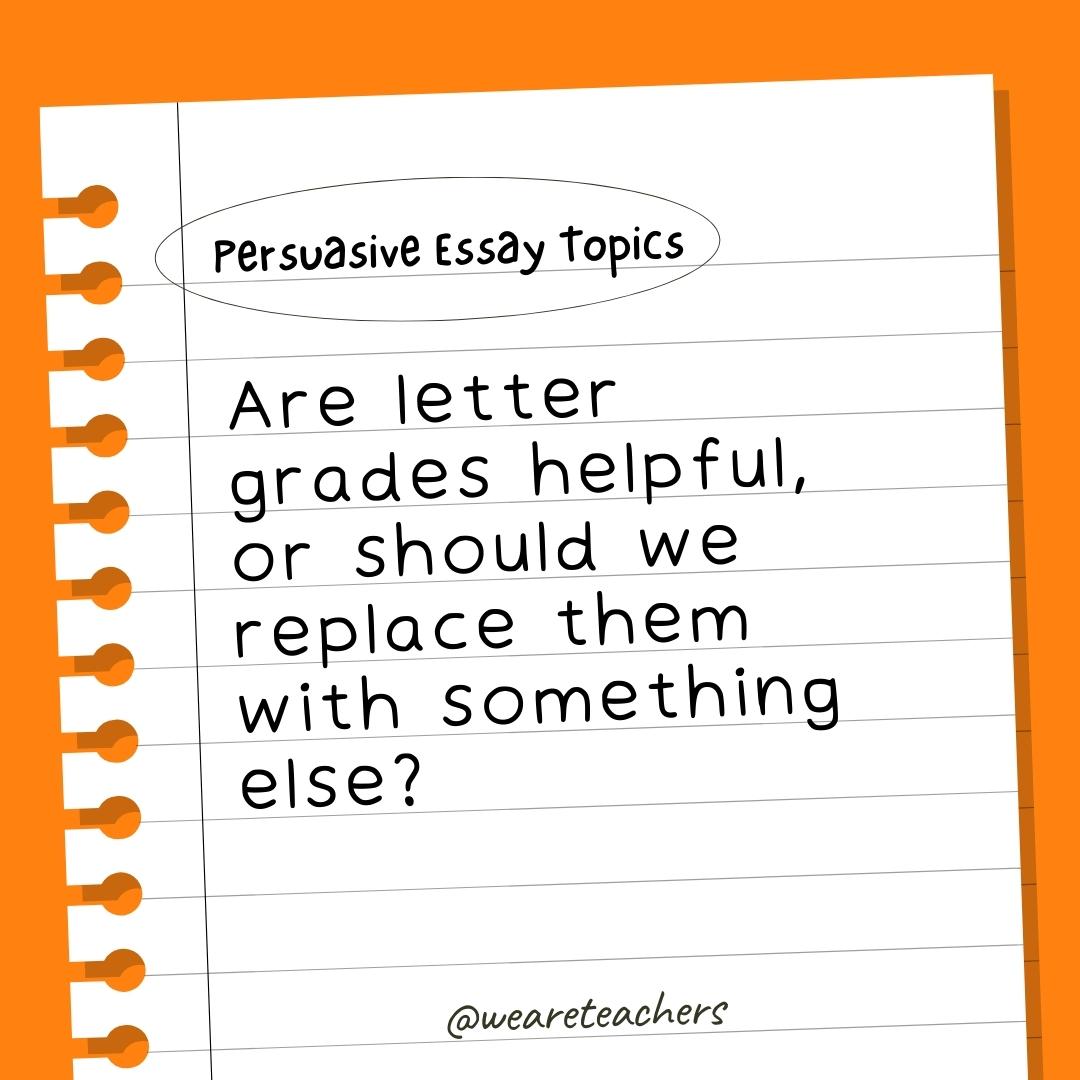
- Is it ever OK to cheat on homework or a test?
- Should students get to grade their teachers?
- Do you think college should be free for anyone who wants to attend?
- Should schools be allowed to ban some books from their libraries?
- Which is better, book smarts or street smarts?
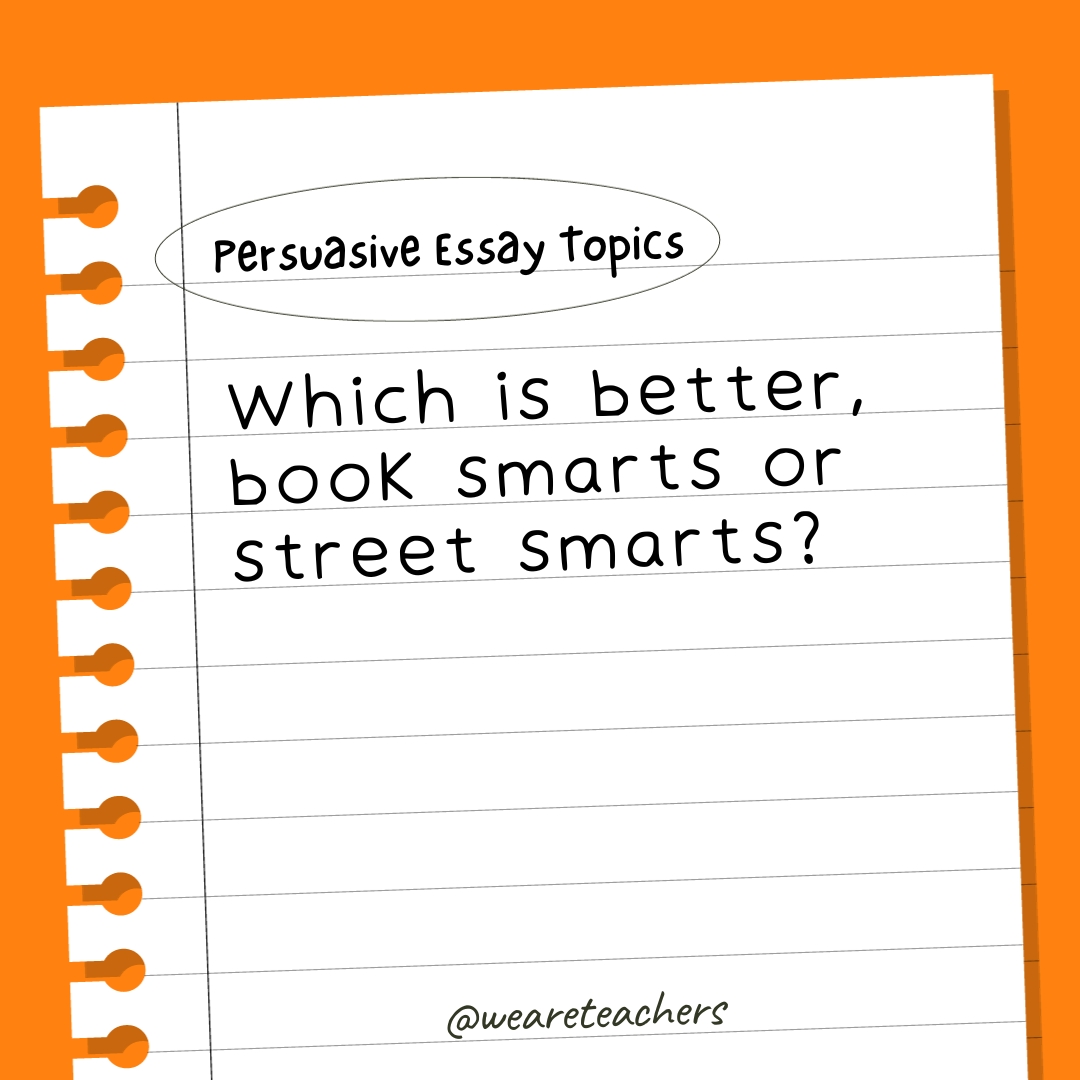
- Should all students have to learn a foreign language?
- Are single-gender schools better or worse for students?
- Is it OK to eat animals?
- What animal makes the best pet?
- Visit an animal shelter, choose an animal that needs a home, and write an essay persuading someone to adopt that animal.
- If you find money on the ground, should you try to find the person who lost it, or is it yours to keep?
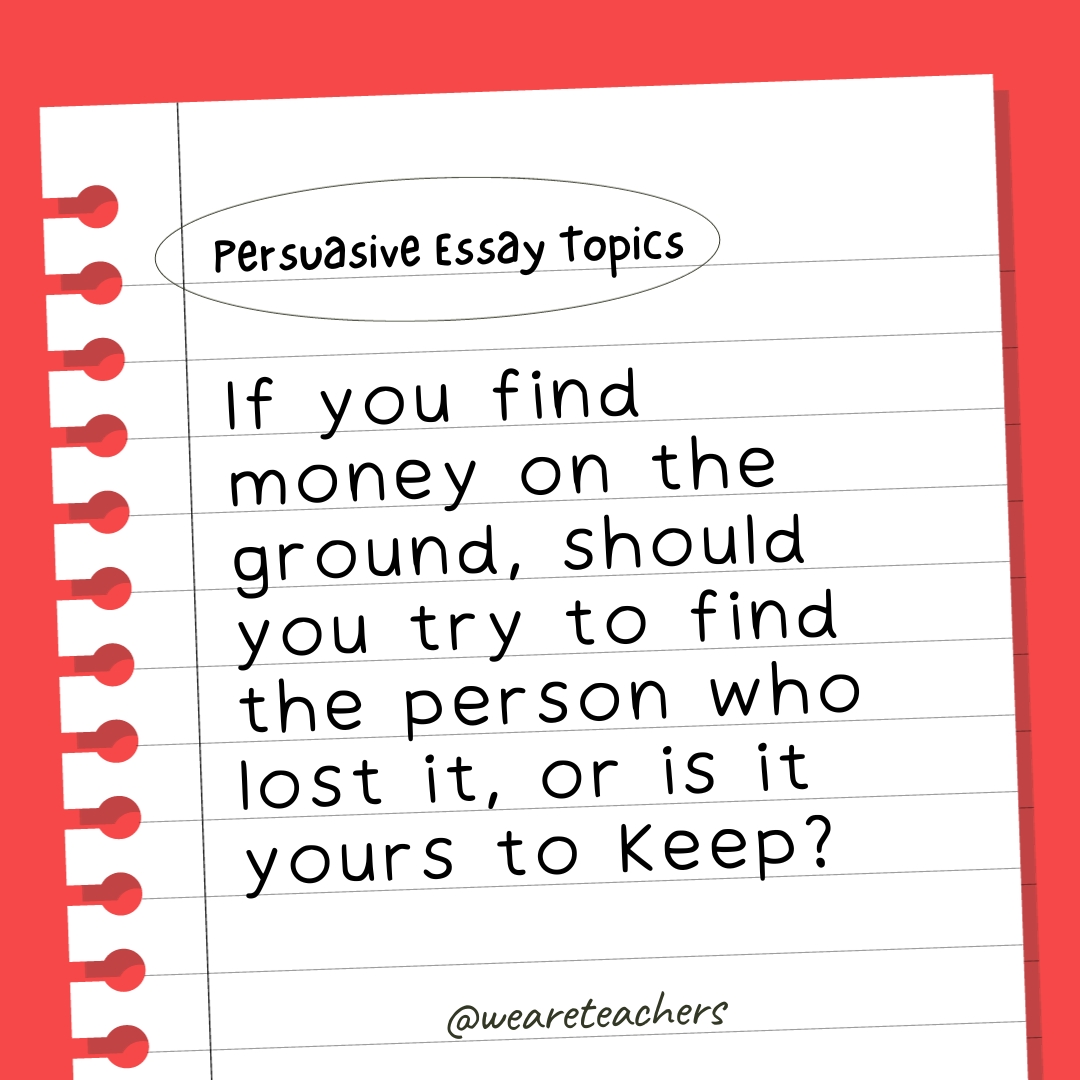
- Who faces more peer pressure, girls or boys?
- Should all Americans be required to vote?
- Is it better to be kind or truthful?
- Which is better, giving or receiving?
- Is it OK to keep animals in zoos?
- Should we change the minimum driving age in the United States?
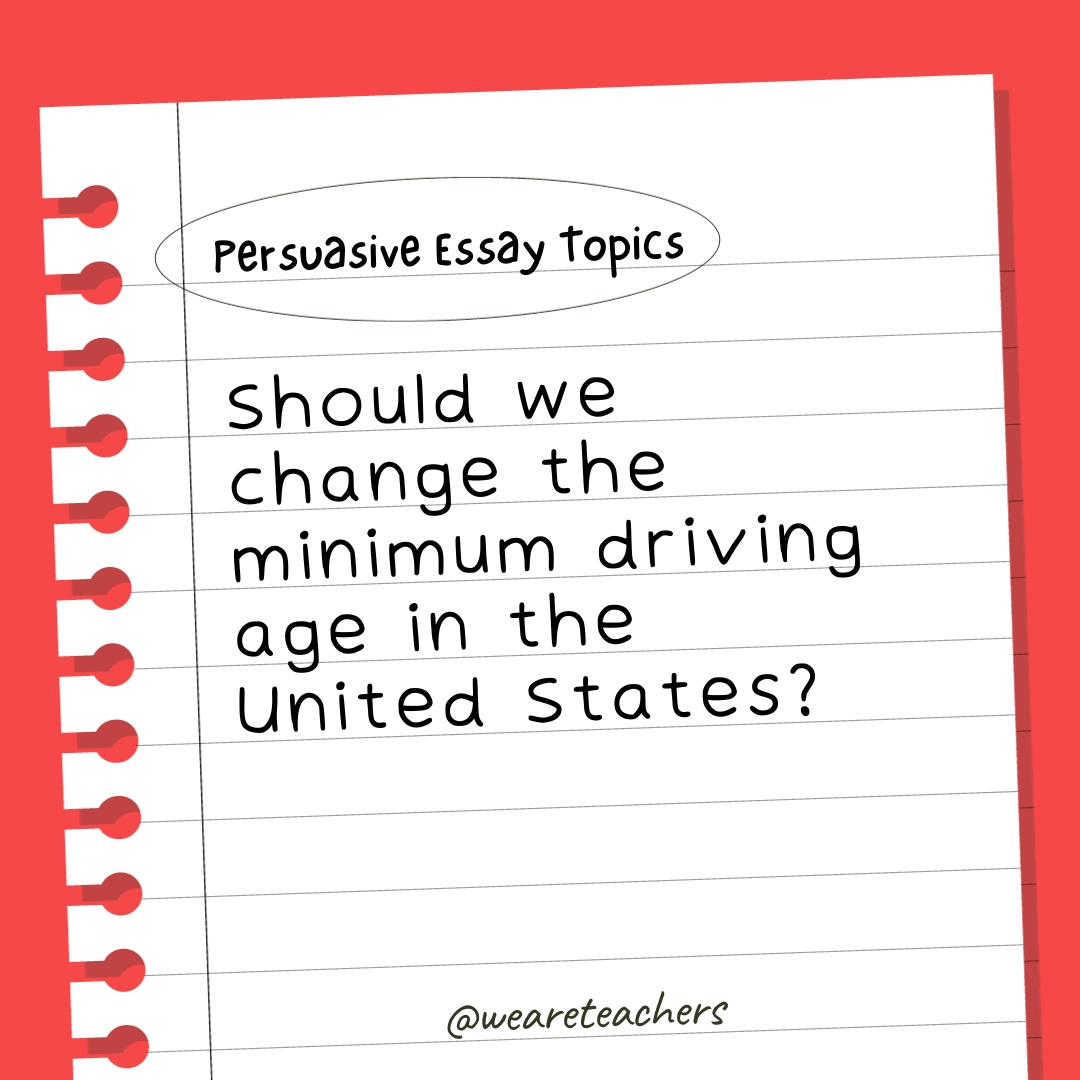
- Which is more important, happiness or success?
- Is democracy the best form of government?
- Is social media helpful or harmful?
- Should parents be punished for their children’s mistakes or crimes?
- Should kids have set bedtimes or just go to bed when they’re sleepy?
- Do you think the government should find a way to provide free health care for everyone?
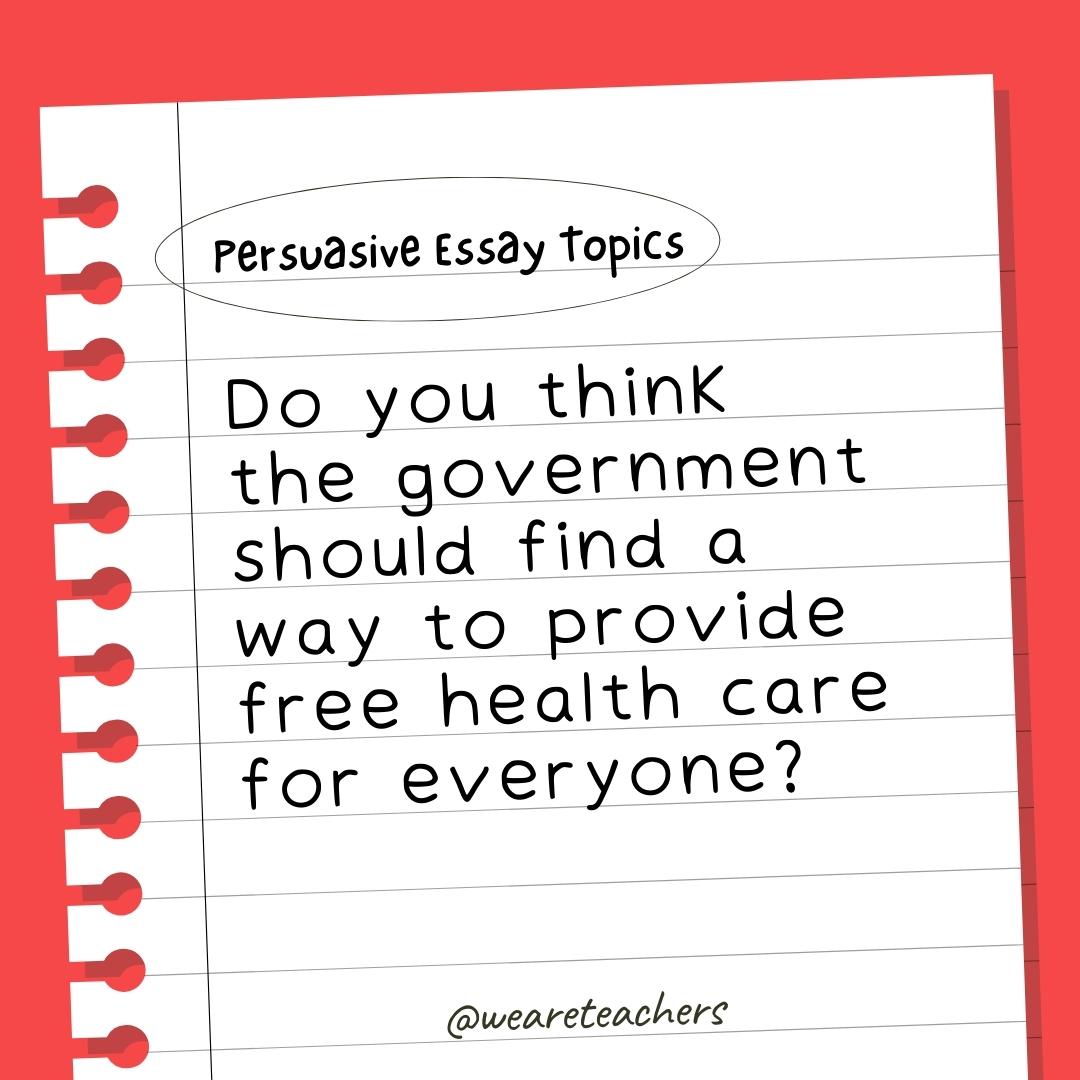
- Is it better to save your allowance or spend it?
- Should we ban plastic bags and bottles?
- Which is better, living in the city or in the country?
- If I could make a new law, it would be …
- Is Pluto a planet?
- Should human cloning be legal?
- Should vaccines be mandatory?
- Is it right for countries to still maintain nuclear weapon arsenals?
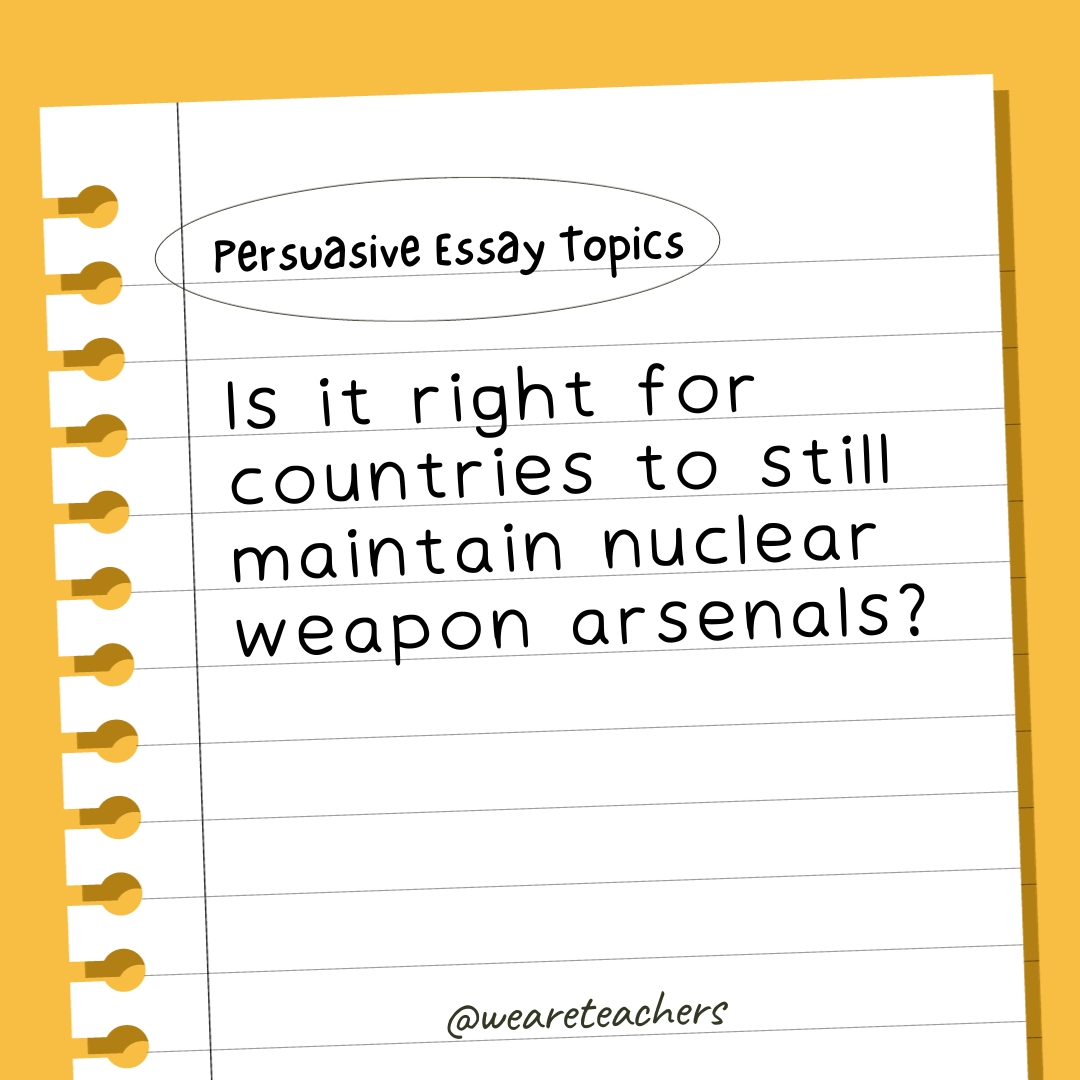
- Should testing on animals be made illegal?
- Will expanded use of artificial intelligence be good for humanity?
- Should all people have free Internet access in their homes?
- Is there intelligent life on other planets?
- Does technology create more jobs than it eliminates?
- Should parents use their children’s cell phones to track where they are?
- Should scientists try to develop a way for people to live forever?
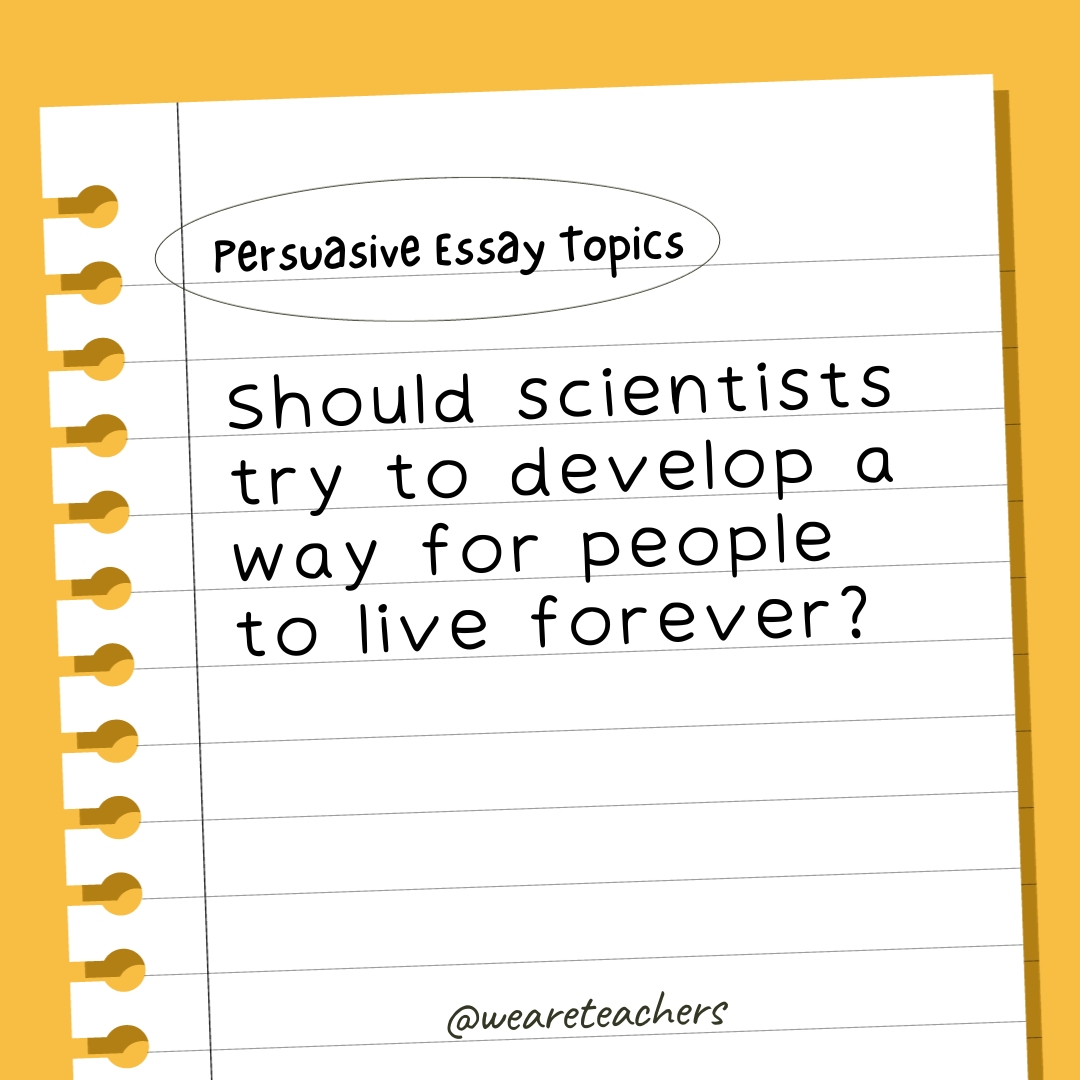
- What’s the best type of smartphone: Android or iPhone?
- Which is better, Macs or PCs?
- Do people rely too much on technology in the modern world?
- Should cryptocurrencies replace cash?
- Should there be a minimum age requirement to own a smartphone?
- Is it important to keep spending money on space exploration, or should we use the money for other things?

- Should kids under 13 be allowed to use social media sites?
- Should we ban cigarette smoking and vaping entirely?
- Is it better to be an animal that lives in the water or on land?
- Should kids be allowed to watch TV on school nights?
- Which is better, paper books or e-books?
- Is the current movie rating system (G, PG, PG-13, etc.) effective?
- Are video games better than board games?
- Should we allow little kids to play competitive sports?
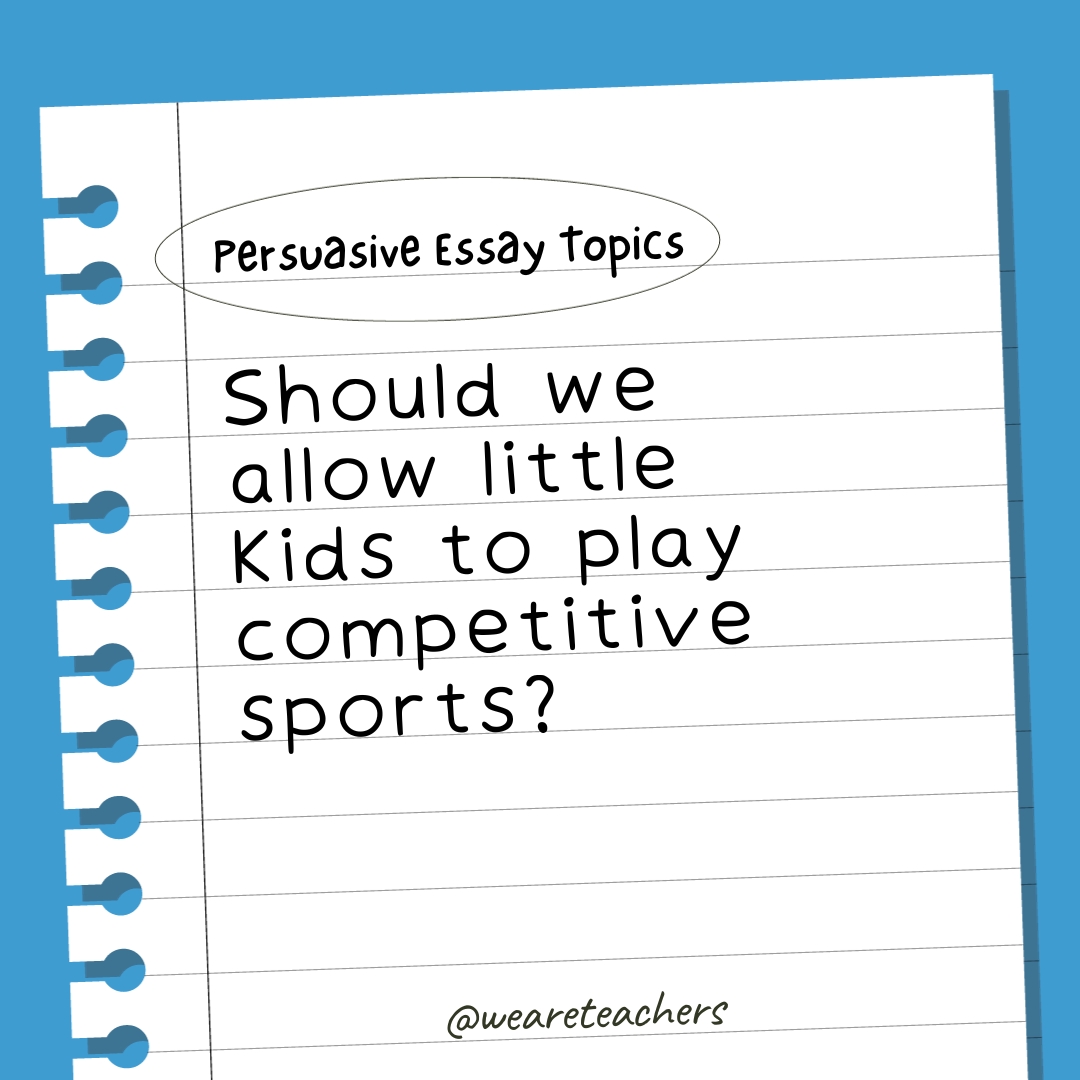
- Which is better, reading books or watching TV?
- Does playing violent video games make people more violent in real life?
- Are graphic novels just as valuable as traditional fictional books?
- Should everyone play on the same sports teams, regardless of gender?
- Choose a book that’s been made into a movie. Which was better, the movie or the book?

- Who is the world’s best athlete, present or past?
- Are professional athletes/musicians/actors overpaid?
- Which is better, fiction or nonfiction?
- The best music genre is …
- What is one book that everyone should read?
- What new sport should be added to the Olympics?
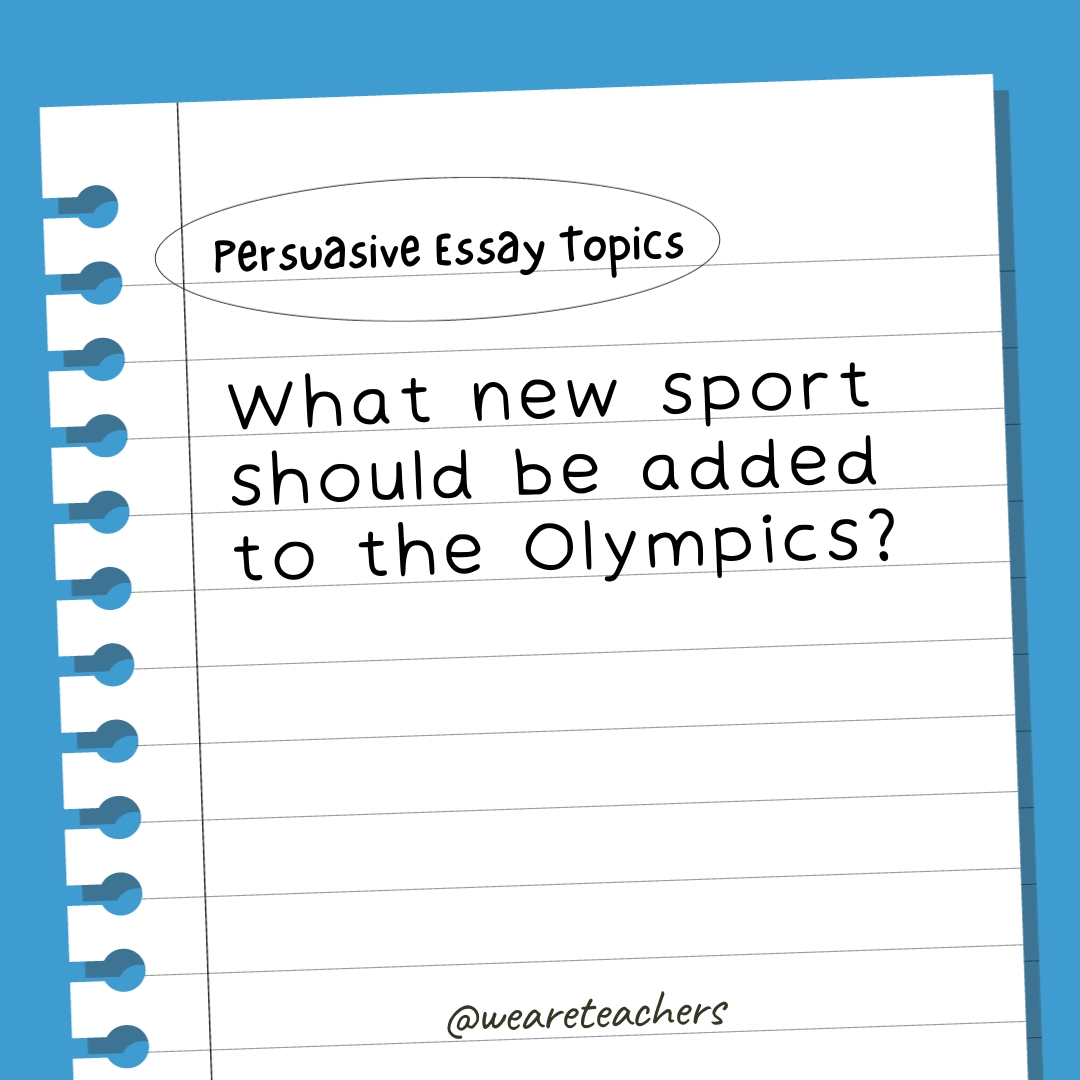
- What’s the best video game system?
- Does playing video games make you smarter?
- Does reality TV actually depict real life?
- Should all neighborhoods have free parks and playgrounds?
- What’s the best holiday?
- The very best food of all time is …
- Which is better, artificial Christmas trees or real ones?
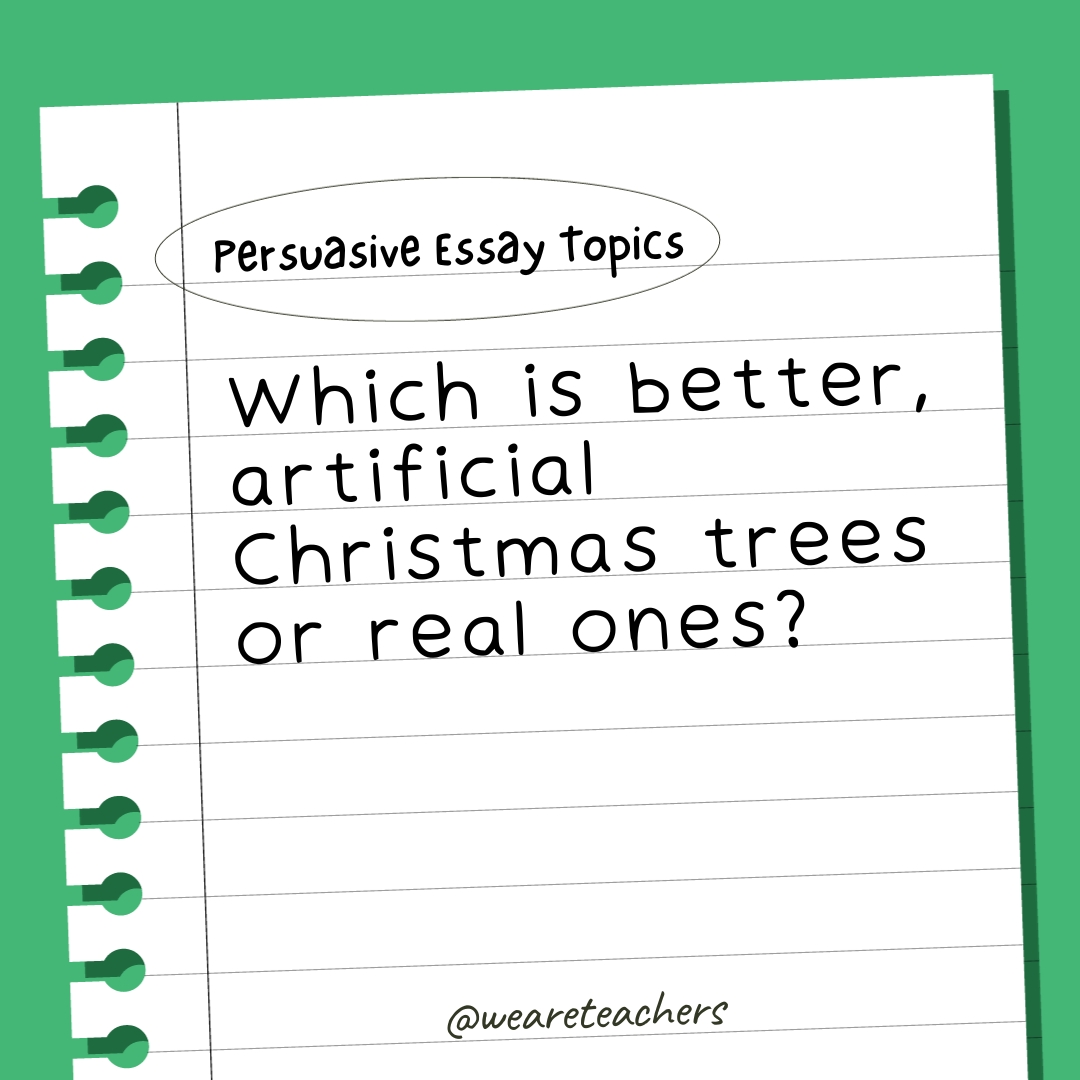
- What’s the best season of the year?
- Should you put ketchup on a hot dog?
- Is a taco a sandwich?
- Does fruit count as dessert?
- Should people have to go to school or work on their birthday?
- Are clowns scary or funny?
- Which is more dangerous, werewolves or vampires?
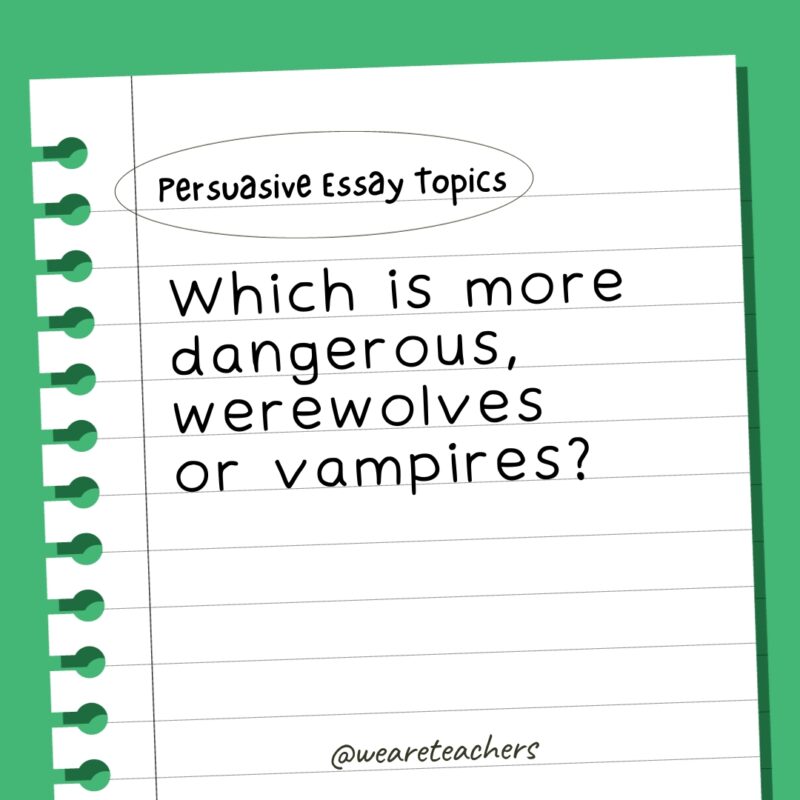
- The best pizza topping is …
- What would be the best superpower to have?
- Should everyone make their bed every day?
- Which came first, the chicken or the egg?
- Should you put pineapple on a pizza?
- Should you eat macaroni and cheese with a spoon or a fork?
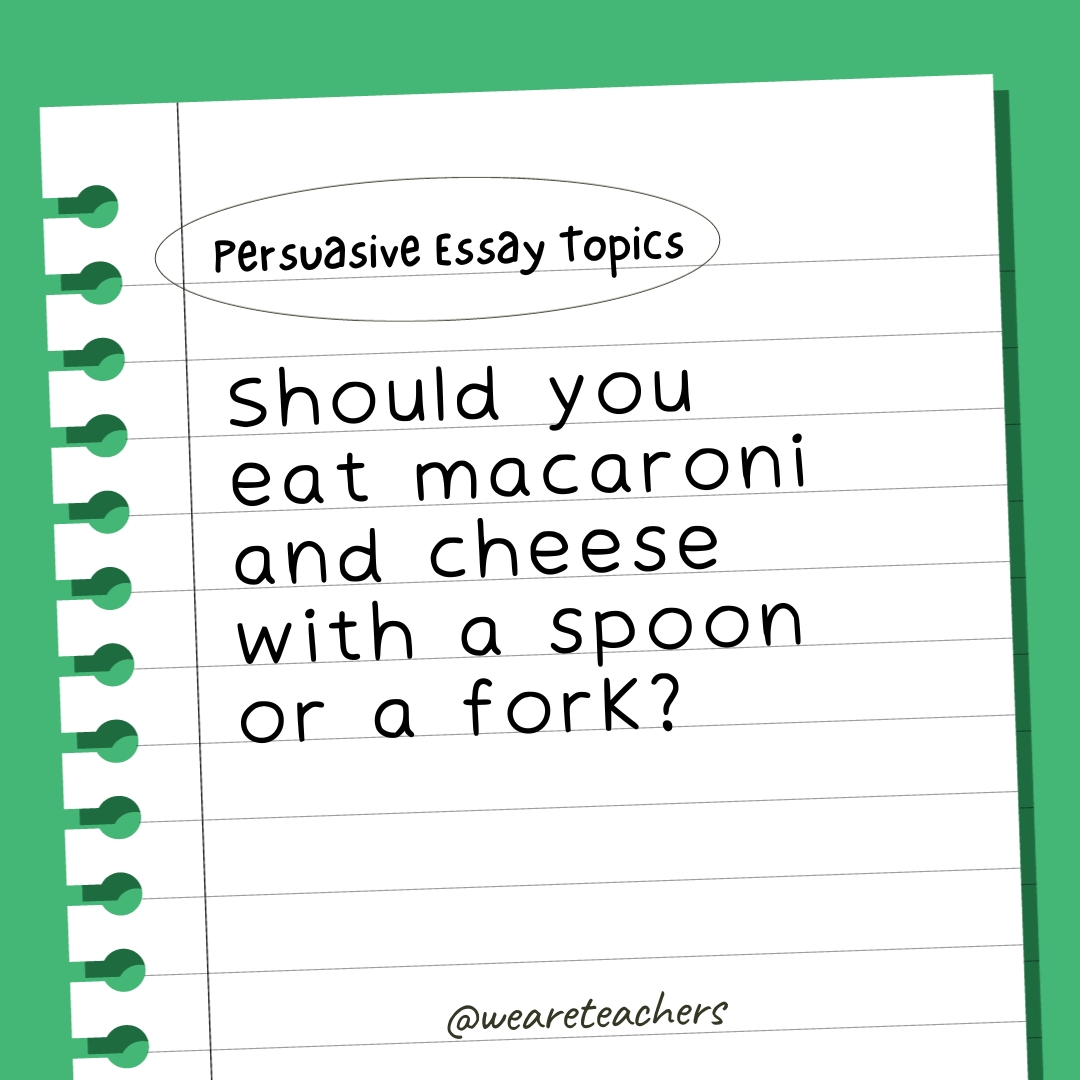
- Describe the world’s best ice cream sundae.
- Is Monday the worst day of the week?
- Would you rather travel back in time or forward in time?
- Is it better to be too hot or too cold?
- Are there aliens living among us here on Earth?
What are your favorite persuasive essay topics for students? Come exchange ideas in the We Are Teachers HELPLINE group on Facebook .
Plus, check out the big list of essay topics for high school (120+ ideas) ..
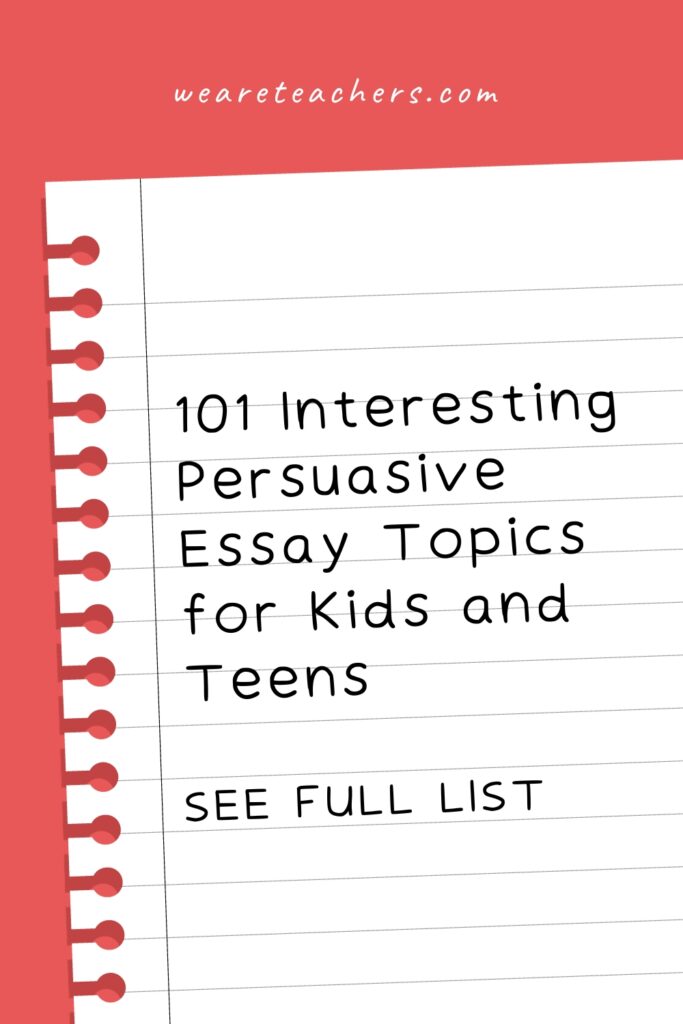
You Might Also Like
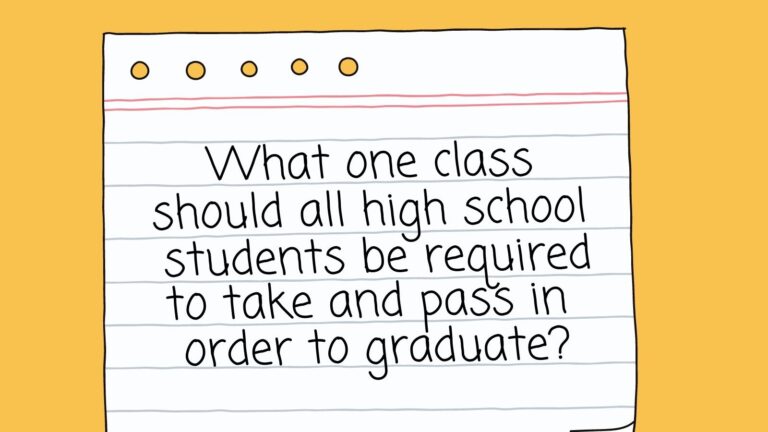
The Big List of Essay Topics for High School (120+ Ideas!)
Ideas to inspire every young writer! Continue Reading
Copyright © 2024. All rights reserved. 5335 Gate Parkway, Jacksonville, FL 32256

IMAGES
VIDEO
COMMENTS
I teach students how to write a step-by-step 5 paragraph argumentative essay consisting of the following: Introduction: Includes a lead/hook, background information about the topic, and a thesis statement that includes the claim. Body Paragraph #1: Introduces the first reason that the claim is valid. Supports that reason with facts, examples ...
Good Argumentative Essay Topic Ideas (and Free, too!) With these 33 new argumentative essay topics for middle school students, you can help your students learn more about what makes a good argument and how to evaluate and decipher so-called "evidence.". As they explore topics like the ways in which schools handle bullying and whether or not ...
My done-for-you Argumentative Writing Unit scaffolds how to write an argumentative essay for you and your students. The unit includes 23 full lesson plans, slide presentations, notebook pages for students, teacher keys and examples, student references pages, and more for a well-rounded unit. Plus, this unit goes through the exact process I ...
100 Thought-Provoking Argumentative Writing Prompts for Kids and Teens. Practice making well-reasoned arguments using research and facts. Writing a strong argumentative essay teaches students to make a case for their own point of view without relying on emotion or passion. These argumentative essay topics provide options for kids of all ages ...
Body paragraph #4: Writing the opposing argument. 1) The opposing argument, called the counterclaim or counterargument, proves that you fully understand the topic and that you have considered the opposition. 2) The turn-back is a return to the original argument. It gives you an opportunity to prove why the opposing argument is invalid.
Use these prompts for students who finish work early and need something to do. To choose a prompt, have students pick a number between 1 and 45. Challenge your students to use one writing prompt every day for a full week. Pick prompts that line up with what students are learning in other classes (like history or art).
In " 10 Ways to Teach Argument-Writing With The New York Times ," you'll find resources for: Exploring the role of a newspaper opinion section. Understanding the difference between fact and ...
argumentative writing prompts for middle school. 26. Discuss ways that teachers can make lessons more accessible to students. 27. State your opinion on whether middle schoolers watch too much television. 28. Describe why it's important not to always judge someone based on how they look. 29. Share the importance of learning study skills.
This list of excellent argumentative essay topics for middle school is sure to give your students the practice they need in getting their arguments down on paper, in a persuasive way. With a variety of topics ranging from whether or not to outlaw animal testing to debating a 3-day weekend, this curated collection will give your kiddos lots of ...
What is an argument essay? An argument essay uses logic and reasoning to defend a position or point of view. In an argument essay, research, evidence, and examples are used to convince the reader to consider a different point of view. A strong argument essay also acknowledges the opposing viewpoint. This is known as the counterargument.
Persuasion Map: Students can use this online interactive tool to map out an argument for their persuasive essay.: Persuasive Strategy Presentation: This handy PowerPoint presentation helps students master the definition of each strategy used in persuasive writing.: Check the Strategies: Students can apply what they know about persuasive writing strategies by evaluating a persuasive piece and ...
An argumentative essay attempts to convince a reader to agree with a particular argument (the writer's thesis statement). The writer takes a firm stand one way or another on a topic and then uses hard evidence to support that stance. An argumentative essay seeks to prove to the reader that one argument —the writer's argument— is the ...
If you're a writing teacher in grades 7-12 and you'd like a classroom-ready unit like the one described above, including mini-lessons, sample essays, and a library of high-interest online articles to use for gathering evidence, take a look at my Argumentative Writing unit. Just click on the image below and you'll be taken to a page where you can read more and see a detailed preview of ...
An argumentative essay is an essay that uses evidence and facts to support the claim it's making. Its purpose is to persuade the reader to agree with the argument being made. A good argumentative essay will use facts and evidence to support the argument, rather than just the author's thoughts and opinions. For example, say you wanted to ...
Make a claim. Provide the grounds (evidence) for the claim. Explain the warrant (how the grounds support the claim) Discuss possible rebuttals to the claim, identifying the limits of the argument and showing that you have considered alternative perspectives. The Toulmin model is a common approach in academic essays.
Do your students write Argumentative Essays that do not use supporting evidence? Are you looking for a thorough way to incorporate both standards based and ...
Use these ReadWriteThink resources to help students build their plans into a fully developed evidence based argument about text: Modeling Academic Writing Through Scholarly Article Presentations. And I Quote. Essay Map. Have students use the Evidence-Based Argument Checklist to revise and strengthen their writing.
The Significance of Argumentative Essays in Middle School. Argumentative essays serve as a powerful tool in the middle school curriculum for several reasons: Critical Thinking: Writing argumentative essays encourages students to think critically. They must evaluate evidence, analyze different perspectives, and form their own opinions.
Write an argumentative essay that argues whether Freeganism should or should not be supported on a larger scale. Develop your essay by providing evidence from both passages. Manage your time carefully so that you can plan your argument and do some pre-writing. Be sure to: - use information from both passages. - avoid over relying on one passage.
Argumentative Essay Examples For Middle School . Middle school essays are pretty basic and easier to debate. Following is an example of middle school argumentative essay: ... When writing an argumentative essay, it is very easy to deviate from the assigned essay length given by your instructor. Writing a 4000-word essay while the maximum essay ...
Matthew Barbee, 2015 1 Name_____ Class_____ In an argumentative essay, your job is make the reader agree with your opinion about a controversial topic. You have to (1) state your opinion, (2) give reasons to support your opinion, and (3) argue against the opposite opinion. Overall, you must convince the audience that your side of the
The Write Source Persuasive Writing Samples; Oregon Department of Education High School Scored Narrative and Argumentative Writing Samples; Holt, Rinehart, Winston Persuasive Essay Models; Reflective writing examples for middle school. Reflective essay examples from Lake Washington Girls Middle School; If you know of any other online writing ...
101 Interesting Persuasive Essay Topics for Kids and Teens. Use your words to sway the reader. Persuasive writing is one of those skills that can help students succeed in real life. Persuasive essays are similar to argumentative, but they rely less on facts and more on emotion to sway the reader.